Matador Network's Blog, page 69
February 10, 2025
Wellness, Thrills, and a Mega Aquarium: Inside Dubai’s Most Iconic Resort

From the moment I walked into Dubai’s Atlantis, The Palm, I felt like I was surrounded by water. The property — which became Palm Jumeirah island’s very first resort when it opened in 2008 — was inspired by the legend of Atlantis, a mythical island lost to the sea. Every detail embraces the aquatic theme, from the seashell fountains to the seahorse carvings on the doors.
The showstopper is the Ambassador Lagoon, an 11-million-liter open-water tank and the highlight of the Lost Chambers aquarium. (That’s more literage than all of the tanks at California’s famous Monterey Bay Aquarium combined.) Just steps away from the lobby, gigantic windows showcase thousands of marine animals that call the aquarium home. Sharks and rays glide past. Schools of colorful fish move in unison. It’s an introduction that instantly sets the tone for the rest of your stay: at Atlantis, The Palm, the underwater world is more than a theme — it’s an experience.

Photo: Jessica Devnani
But facilitating that experience also means doing so responsibly. Atlantis, The Palm, is accredited by the Association of Zoos and Aquariums (AZA), meaning it meets the highest standards in animal care, facilities, and guest experience. It’s also a member of the World Association of Zoos and Aquariums (WAZA), a global alliance working to improve animal welfare, conservation, and education.
Another way the resort is making waves is the Atlantis Atlas Project, an initiative that donates one dollar to conservation and sustainability efforts for every marine animal activity booked. The project focuses on four species — sharks, rays, dolphins, and corals — and two major threats to their survival: unsustainable seafood and plastic pollution. Earlier this year, the project helped release three honeycomb stingrays and 20 Arabian carpet sharks born at the resort into the Arabian Gulf.
For guests who get to spend their stays mesmerized by the resident marine life at Atlantis, The Palm, it’s important to know that the resort not only cares for its animals but also does its part to protect marine life in the wild. In a funny way, that almost describes the guest experience, too. While you’re at Atlantis, The Palm, you can expect equal parts pampering and adventure — and that means that you’ll leave the property feeling rested and enriched when it’s time for you to return home.
The rooms at Atlantis, The Palm: From comfort to extravagance
Photos: Jessica Devnani
There are 1,544 rooms at Atlantis, The Palm, ranging from standard guest rooms to signature suites. Room rates start at about $35 per night, with the resort’s six ultra-luxurious signature suites starting around $3,000 per night. The most iconic suite is the Underwater Suite, thanks to its floor-to-ceiling windows that look out into the Ambassador Lagoon. (Another perk: the nearly 1,800-square-foot accommodation also comes with round-the-clock butler service.)
I stayed in a King Guest Room with Palm View, which meant I had a lovely view of Palm Jumeirah, but you can also opt for an Ocean View room that overlooks the Arabian Sea. Mornings were my favorite time in the room as I’d spend them watching the sunrise over Dubai’s skyline from my balcony. One fun feature of the room was that you could also take in the view while relaxing in the bath — the incredibly spacious bathroom includes a large tub (complete with bubble bath) and a sliding door that opens up to the main room.
The level of care from the housekeeping team was outstanding. After returning to my room the first evening, I found my cables fitted with Nemo cable protectors, a thoughtful touch from my housekeeper, Naveem, who knew me by name. Each day my room was replenished with fresh fruit, including my favorite but rare tropical fruit: mangosteen. Because the resort has completely eliminated single-use plastics, you’ll also find refillable glass bottles, which have been purified at the on-site plant, replenished daily instead of bottled water.
Wellness at Atlantis, The Palm: Meditation, massages, and more
Photo: Jessica Devnani
Wellness offerings at Atlantis, The Palm, are extensive. At the AWAKEN Spa, you can book everything from facials and massages to Reiki energy therapy and chakra balancing, as well as regenerative AEON Clinic services (think botox, fillers, and IV therapy). In addition to cutting-edge equipment, personal trainers, and guided sessions like yoga and meditation, more therapies (of the cryo chamber variety, for example) await at the AWAKEN Fitness center.
One of the most memorable experiences of my stay was an underwater sound healing meditation. We weren’t actually underwater but instead in a room with three massive floor-to-ceiling windows facing the Ambassador Lagoon. I was joined by a few other guests, and we each had a yoga mat to either sit or lie on. For the next 45 minutes, our sound healer, Eugenie, led us on a journey as the tones and vibrations of the sound bowls filled the space.
Normally, I’d keep my eyes closed during a meditation, but I couldn’t pass up the opportunity gaze up at the aquarium this time. This was an entirely new meditative state. I watched rays and fish drift by as the reflection of the sunlight danced in the water. It felt as if the sounds were connecting me to the tranquility of water and the flow of nature. For the first time in a while, I felt truly present.

Photo: Jessica Devnani
Another morning, I started the day with an hour-long massage at the beautiuflly designed spa, where streams run through the halls in keeping with the resort’s aquatic theme. As suggested, I arrived a bit earlier than my appointment to make use of the spa facilities. I was greeted with a refreshing herbal drink and then shown to my locker. The jacuzzi, sauna, and steam room left me in an already relaxed state before my massage even began.
When I finally met my massage therapist, Fetery, she asked several questions before getting started and really took the time to tailor the massage to my individual needs. I was grateful for her attention to the knots in my back and left feeling rejuvenated.
Adventure at Atlantis, The Palm: A waterpark to remember
Photos: Jessica Devnani
Staying at Atlantis, The Palm, includes complimentary access to the on-site waterpark, Aquaventure. This isn’t just any waterpark — it’s the world’s largest waterpark, with over 105 slides and attractions. Some were made for adrenaline lovers, such as the Leap of Faith slide, a near-vertical drop that shoots you through a shark-filled tunnel. Other activities, like chilling in one of the lagoons or tubing down the lazy river, are more relaxing. My personal favorite was the Odyssey of Terror, a group tube slide that sends you flying up two massive wave-shaped walls where you’ll feel a moment of weightlessness before plunging back down.
Guests also receive complimentary entry to the Lost Chambers Aquarium, a labyrinth-like space designed to feel like the ruins of the lost island of Atlantis. Over 65,000 marine animals call this place home, and you can get up close and personal with them if you book a snorkel or dive session. I opted to try the Aquatrek Xtreme, during which you wear a helmet connected to an air supply and descend about 30 feet to walk along the aquarium floor. Standing underwater among the sea life — all while your head remains completely dry — is a surreal experience that I’d highly recommend. You can even wave to guests viewing the aquarium from the other side.
Dining at Atlantis, The Palm: Nobu, enough said
Photo: Jessica Devnani
It’s no surprise that a resort as large and thoughtfully designed as Atlantis, The Palm, has a comprehensive culinary program. On-site dining venues are loosely grouped into three categories: celebrity chef restaurants, signature restaurants, and casual restaurants. Add in various lounges, cafes, and fast-casual spots, and you’ll never have to eat at the same spot twice if you don’t want to.
For me, and many others, Nobu tops the must-eat list. Led by Chef Nobu Matsuhisa, this eponymous restaurant is famous for crafting innovative dishes that blend traditional Japanese flavors with Peruvian ingredients. Go for the omakase menu (a Japanese dining experience where guests entrust their meal selection to the chef). At Nobu, this includes a seven-course meal. I’m a big fan of sushi, so my favorite courses were the sashimi and nigiri, plus a shoutout to the beef toban yaki (marinated beef that’s cooked on a hot ceramic plate). Pro tip: check out the view from the restaurant’s 22nd-floor terrace while you’re there.
Hakkasan is another restaurant you shouldn’t skip. The Michelin-starred restaurant brings a sleek, modern edge to Cantonese cuisine. The first thing I noticed upon entering was the atmosphere — dimly lit with cool blue undertones. I asked my server for a recommendation and ended up with the premium dim sum, which was almost too gorgeous to eat. Then came the Boston lobster, which was heavy on chili and garlic and an explosion of flavor with every bite. I asked for a unique cocktail and was presented with the Mistress of Deception, a coral-colored concoction with a smoke-filled bubble on top. Presentation at Hakkasan is not something to be missed, but rest assured that every dish tastes just as incredible as it looks.
How to get to Atlantis, The PalmFrom Dubai International Airport (DXB), a taxi or Uber will get you to the hotel in about 35 minutes for roughly $35-$45. Complimentary airport transfers are included for guests staying in suites. 
This Estate in White Lotus Season 3 Is Available on Airbnb

The White Lotus season 3 debuts February 16, and you can book one of the luxury properties featured in the show on Airbnb. While the Four Seasons Resort Koh Samui serves as the primary setting for The White Lotus Season 3, properties like Samujana Twenty-Seven provide the perfect backdrop for the show’s exploration of luxury, privilege, and the complexities of human nature. The villa‘s blend of modern luxury and traditional elements mirrors the show’s themes, making it an ideal location for filming.
Built atop a hill near Chaweng Beach, Samujana Twenty-Seven offers panoramic views of the Gulf of Thailand. You and your crew can run to the water, play all morning, and be back in the chef’s kitchen for lunch, no problem. The villa’s design mashes contemporary minimalism with elements of traditional Thai architecture – but its main element is undeniably luxury. Expansive glass walls invite natural light, creating a harmonious connection between indoor and outdoor spaces. The use of natural materials, such as teak wood and local stone, calls to mind a mountain retreat, which isn’t too far off, as the home is built on a hill, after all.
Traveling to Thailand? Check out Matador’s Thailand accommodations guides: Soak in Bangkok’s Epic Skyline From These Airbnbs Across the City The best Chiang Mai hotels inside and outside the walls See the Best of Chiang Mai From These Luxurious Airbnbs Everything you need in your pack to travel to Southeast Asia
We hope you love Samujana Twenty-Seven! Just so you know, Matador may collect a small commission from the links on this page if you decide to book a stay. Listed prices are accurate as of the time of publication.
What’s special about Samujana Twenty-Seven Photo: Airbnb
Photo: Airbnb Photo: Airbnb
Photo: Airbnb Photo: Airbnb
Photo: Airbnb Photo: Airbnb
Photo: AirbnbSee more photos
This is no ordinary beach house. Check out what you’ll revel in during a stay:Private infinity pool: A stunning infinity pool that appears to merge with the azure sea, offering a serene spot for relaxation.Sunken lounge: An outdoor sunken lounge area, perfect for intimate gatherings or tranquil moments, all while overlooking the breathtaking seascape.Spacious living areas: Open-plan living spaces equipped with state-of-the-art entertainment systems and plush furnishings, ensuring comfort and luxury.Gourmet kitchen: A fully equipped kitchen featuring modern appliances, ideal for those who wish to indulge in culinary pursuits.Movie room: An in-house cinema room for guests to enjoy films in a cozy, private setting.Fitness center: A well-appointed gym with modern equipment for fitness enthusiasts.About Samujana Twenty-Seven
 Photo: Airbnb
Photo: Airbnb Photo: Airbnb
Photo: Airbnb Photo: Airbnb
Photo: Airbnb Photo: Airbnb
Photo: AirbnbSee more photos
Samujana Twenty-Seven comprises multiple bedrooms, each thoughtfully designed to provide maximum comfort and privacy. The master suites feature king-sized beds, en-suite bathrooms with soaking tubs, and private terraces that offer unobstructed sea views. The additional guest rooms are equally luxurious, ensuring that all occupants experience the pinnacle of comfort.
A notable feature of the villa is the presence of a Buddha statue that presides over the serene sea views, adding a touch of spirituality and cultural significance to the space. This element not only enhances the aesthetic appeal but also provides guests with a sense of place, reminding them of Thailand’s rich cultural heritage.
Located near Chaweng Beach, the villa offers easy access to one of Koh Samui’s most popular beaches, known for its vibrant nightlife, dining, and shopping options. Guests can explore local markets, indulge in authentic Thai cuisine, or partake in water sports, all within a short distance from the villa. 
Price: $3,040 per night
More like thisTravelChannel Your White Lotus Fantasy at These Thailand AirbnbsIf You Enjoy Cherry Blossom Season, You’ll Love These Other Spring Bloom Destinations
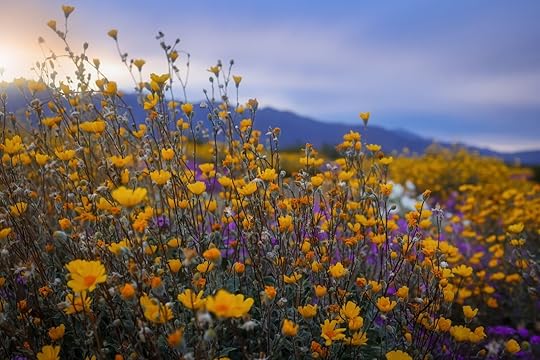
As winter loosens its grip, there’s nothing quite like the sight of fields of tulips, poppies, bluebonnets, or carpets of columbines to signal spring’s arrival.
The season begins with wildflowers and daffodils that awakens the countryside out of slumber and continues with a kaleidoscope of colors that lead the way to summer. Cherry blossom often takes center stage in spring; its delicate white and pink petals and perfume draw a crowd in towns and cities across the country. And rightly so. For many, seeing blossom is an annual tradition. But there’s so much more to celebrate.
From March, forest floors of national parks are rustling with the first wildflowers, parts of California are blanketed in super blooms and poppies, the Texas Hill Country is painted blue with bluebonnets, and Charleston is draped in wisteria.
Enjoying these stunning displays shouldn’t be a rushed afternoon activity. To get the most out of nature in spring, why not plan a getaway around these blooms? It might end up being one of the most cherished trips you take this year.
The annual blooming schedule of different species is naturally influenced by preceding weather patterns, not only of this season but also the conditions of the preceding autumn and winter. This guide will give you a general idea of when you should travel, but it’s advisable to check in with a national park, other wildlife organization, or a local in the know before you visit.
We hope you love the spaces and stays we recommend! Just so you know, Matador may collect a small commission from the links on this page if you decide to book a stay. Listed prices are accurate as of the time of publication.
The Antelope Valley California Poppy Reserve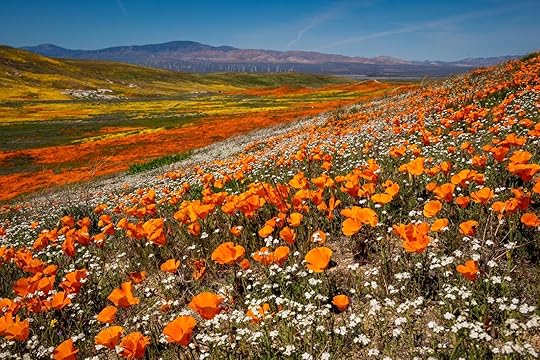
Photo: MierCat Photography/Shutterstock
What’s in bloom: The California poppy
When to go: Late March to May
Rolling hills of orange California poppies are one of the most impressive displays of spring blooms in the US. One of the best places in Southern California to experience the delicate flower in all its glory is the Antelope Valley Poppy Reserve. The California poppy self-seeds, so once there’s an established colony, it can cover a lot of ground. And the natural reserve — 15 miles west of the city of Lancaster — has eight miles of beautiful trails where you can saunter through thousands of poppies. Peak bloom is approximately mid-March through May, depending on rainfall. Check Antelope Valley Poppy Reserve’s website and social media for updated information. There’s also a live poppy cam.
Where to stayYou can base yourself in Lancaster to be close to city amenities, and there’s an impressive range of Airbnbs available, from modest apartments to enormous gated mansions. If you’re happy to add an extra 10-minute drive, check out this listing at Agua Dulce Winery. It’s located around 40 minutes from the park and compliments a day of viewing the poppies beautifully. The four-bedroom home is on a private 90-acre estate, and you can roam the grounds and visit the vineyard’s tasting room and wine cellar during your stay. You might also want to bookmark one of Madador’s favorite Airbnbs to stay in March, this spacious three-bedroom, two-bathroom home in the heart of Tehachapi. It is a little more remote, so not only will you have stunning views over the mountains but exceptional stargazing conditions.
Great Smoky Mountains National Park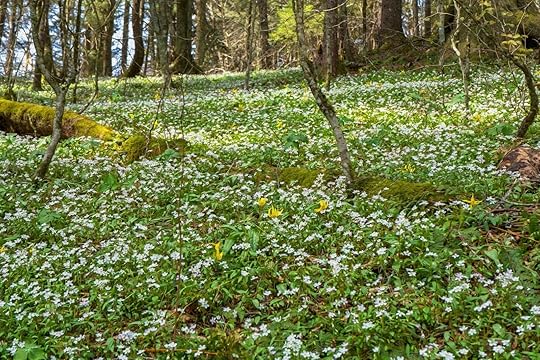
Photo: Donna Bollenbach/Shutterstock
What’s in bloom: Wildflowers
When to go: March to June
Spring in the Great Smoky Mountains National Park is undoubtedly one of the best times to visit. The season’s wildflower displays have earned the Smokies the nickname “Wildflower National Park.” There are over 1,500 flowering plant species, with over 80 percent of them wildflowers. This abundance and the mild temperatures make spring an ideal time to explore the park’s trails and witness this natural spectacle.
The park’s varying elevations create a staggered blooming season, extending the wildflower viewing period from March through June. You might, however, want to plan a visit around the annual Spring Wildflower Pilgrimage non-profit event, which offers guided hikes, seminars, and educational programs.
Among the earliest arrivals are the delicate hepaticas, both sharp-lobed and round-lobed, their white, pink, purple, or pale blue blooms often appearing in late winter at lower elevations. Bloodroots grace the forest floor as March progresses, particularly along trails like Porters Creek and Chestnut Top. Violets, with their varied hues, also begin to emerge, adding splashes of color to the early spring landscape. April brings the peak of trillium season, making trails like Middle Prong and Cove Hardwood ideal for wildflower viewing.
Where to stayAsheville’s friendly, outdoorsy vibe is the perfect landing spot for your Great Smoky Mountains getaway. Asheville is located between the Great Smoky Mountains and the Blue Ridge Mountains, and you’re under an hour’s drive to the park gates, which will take you past many pull-offs where you can enjoy the views along the way. When it comes to Airbnbs in Asheville, the choice is outstanding. There are woodland glass homes, newly built A-frames, and some of the most beautiful cabins in the US. With so many options, play around with Airbnb’s category features and filter by tiny homes, cabins, or tree houses for a stay that will complement your days of viewing the wildflowers, and check out Matador’s complete guide to the best Airbnbs in Asheville.
Modesto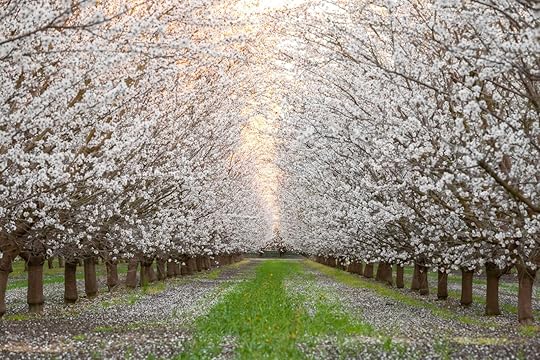
Photo: Guangli/Shutterstock
What’s in bloom: Almond blossom
When to go: Mid-February to mid-March
Cherry blossoms get most of our attention in spring, but almond blossoms put on an equally impressive show in California’s Central Valley. In the heart of the almond country, the city of Modesto is surrounded by over 1.5 million acres of almond orchards, and come mid-February to mid-March, people visit from far and wide to witness the white and pink blooms. You can take Modesto Almond Blossom Cruise, a downloadable audio tour that provides turn-by-turn directions to prime blossom viewing locations, stories from Modesto locals, and is narrated by Modesto native Timothy Olyphant. Or you can create your own itinerary, all you need to do is follow the sweet scent of the blossoms.
Where to stayFor an Airbnb with personality, check out this redwood and glass treehouse a few minutes from downtown. It’s close to everything you need from Modesto but feels secluded, elevated among the trees. Or if you’d prefer to be out of town, this top one-percent listing is situated in the middle of 20 acres of walnut trees just north of the city.
Need some travel inspiration for spring? Check out Matador’s accommodation guides: The Most Stunning Airbnbs to Book for February The Most Stunning Airbnbs to Book for March The 25 Dreamiest Island Airbnbs in the US 13 winter wonderlands Airbnbs for those who need last-minute getawayThe Most Wish-Listed US Cabins on Airbnb Skagit Valley
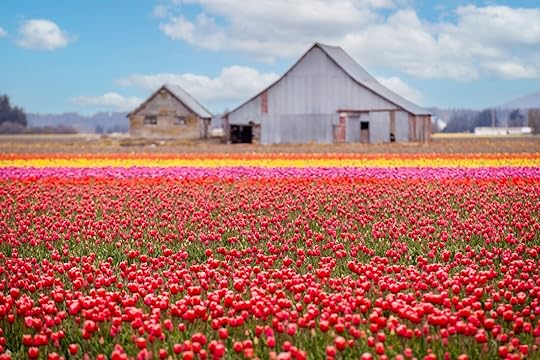
Photo: Edmund Lowe Photography/Shutterstock
What’s in bloom: Daffodils and tulips
When to go: March to early April
As temperatures begin to rise in the Pacific Northwest, the fertile soil of the Skagit Valley erupts with millions of tulips and daffodils. The Skagit Valley, between the Puget Sound and the Cascade Mountains, provides the ideal conditions for these spring blooms. Its mild maritime climate and rich soil are ideal for bulb cultivation, making it one of the premier flower-growing regions in the United States. The floral display begins with the daffodils, typically in late March and early April. From early to mid-April, the valley explodes in a kaleidoscope of colors, with fields of tulips stretching as far as the eye can see. The Skagit Valley Tulip Festival, a celebrated annual event, coincides with the peak tulip bloom. Several growers open their farms to the public, offering opportunities to walk among the tulips, learn about bulb cultivation, and purchase bouquets to take home.
Where to stayLocated roughly midway between Seattle and Vancouver, the valley is easily accessible by car. However, it’s so beautiful you might want to stay local, especially if you can snag yourself a waterfront Airbnb near the festival grounds, such as this glass-fronted cabin near the town of La Conner or this beachfront house with panoramic views of the Saratoga Passage.
Charleston
Photo: Jodi E/Shutterstock
What’s in bloom: Azaleas and wisteria
When to go: Mid-March to early April
Come spring, you’ll smell the clove-scented perfume of azaleas in many parks and gardens in Charleston. Azaleas come in various colors, from white to light pink, deep rose, vibrant fuchsia, and lavender. You can enjoy the display at White Point Garden, Hampton Park, and the Magnolia Plantation. But perhaps the star of the show at this time of year is the city’s wisteria. The fragrant, cascading vines drape over fences, porches, and trees, transforming the city into a lavender-hued paradise. Experiencing this floral spectacle requires understanding the timing of the blooms, which is pretty limited to two to three weeks in mid to late March. The historic streets of the city’s downtown area, particularly in neighborhoods like the French Quarter, South of Broad, and Harleston Village, are prime locations for wisteria viewing. And you can do so on foot thanks to Charleston’s narrow streets and gardens. You’ll often find the most spectacular wisteria displays tucked away in unexpected corners, so give yourself time to explore and enjoy the city in bloom.
Where to stayDue to Charleston being such a popular destination for bachelorettes, plenty of properties are available with ample outdoor space and amenities such as pools and grills. But of course, if you’re a solo traveler or couple, there are many options, too, from cozy condos to guest suites in historic homes. Consider filtering your search by the design category in Airbnb, as you’ll tend to find properties that are not only beautiful but have retained elements of the past, which is part of the experience of staying in the Lowcountry.
Rochester
Photo: JWCohen/Shutterstock
What’s in bloom: Lilacs
When to go: Mid-May
Mid-May in Rochester, New York, is a spectacular time to visit as the city bursts into color with the fragrant bloom of lilacs. Highland Park, home to the largest collection of lilacs in North America, becomes a floral paradise with over 500 varieties showcasing shades of purple, pink, and white. This annual bloom coincides with the Rochester Lilac Festival, the largest free festival of its kind in the country, drawing visitors to enjoy live music, art vendors, delicious local food, and family-friendly activities. The sight of thousands of lilacs in full bloom, paired with the festival’s lively atmosphere, makes for a unique alternative to cherry blossoms — and it’s easy to access from both New York City and Boston.
Where to stayUpstate New York is home to many highly rated Airbnbs, including a slew of romantic mountain cabins. If you don’t mind staying outside the city, you can find a cool A-frame cabin to rent, but if walkability is top of mind for you, then check out Airbnb rentals in the city’s urban core. Rochester is known for the Garbage Plate, which is basically the kitchen sink of what the chef has in the kitchen and the city’s most famous dish — so in your accommodations considerations, consider nearby restaurants like Nick Tahou Hots.
Shenandoah National Park
Photo: Carolyn Franks/Shutterstock
What’s in bloom: Dogwood blossom
When to go: Mid-April to early May
Mid to late spring in Shenandoah National Park welcomes the delicate white and pink blossoms of the flowering dogwood (Virginia’s state tree) blanketing the park’s scenic landscapes. Winding along Skyline Drive, visitors can witness these elegant blooms dotting the forests, creating a stunning contrast against the fresh green foliage and distant Blue Ridge Mountains. This season offers ideal hiking conditions, with mild temperatures and vibrant wildflowers carpeting the trails. While the park itself does not host a specific dogwood festival, nearby towns like Charlottesville and Winchester celebrate spring with the Shenandoah Apple Blossom Festival, featuring parades, concerts, and outdoor festivities. The combination of natural beauty and seasonal celebrations makes spring an unforgettable time to explore Shenandoah.
Where to stayShenandoah National Park is surrounded by a collection of beautiful Airbnbs, which offer both privacy and remoteness coupled with a short commute to Skyline Drive. Staying in nearby Charlottesville allows you to rent an Airbnb within walking distance to restaurants and nightlife, which could be a good idea as a toast is all but appropriate after a day of hiking through fields of wildflowers.
Colorado Springs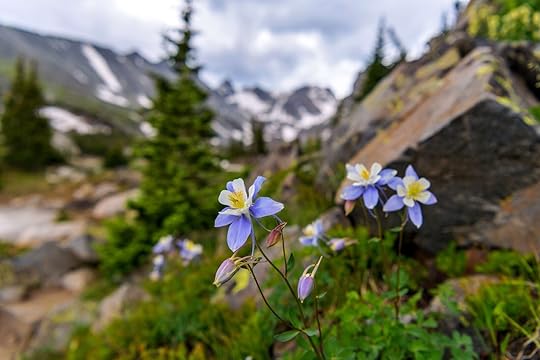
Photo: Sean Xu/Shutterstock
What’s in bloom: Columbines
When to go: Mid-May to early June
Late spring and early summer in Colorado Springs is a magical time as the Rocky Mountain columbine, Colorado’s state flower, begins to bloom across the region’s stunning landscapes. These delicate, blue-and-white wildflowers thrive in the foothills and alpine meadows, adding vibrant splashes of color to scenic spots like Garden of the Gods, Pikes Peak, and North Cheyenne Cañon Park. The mild weather and clear mountain views make this an ideal season for hiking, photography, and wildlife spotting. Hiking is aplenty around Colorado Springs, though you can also drive to the top of Pikes Peak and see the flowers along the route.
Where to stayColorado Springs is a big city but hits like a small town, with quaint neighborhoods offering cute Airbnb homes that you can rent for the duration of your stay. If you’d rather stay up in the high country, the state offers everything from mountain cabins to cannabis-friendly Airbnbs to choose from. Or go all-in and stay at the foot of Pikes Peak itself.
Anza-Borrego Desert State Park
Photo: SNEHIT PHOTO/Shutterstock
What’s in bloom: Wildflowers
When to go: March
Springtime in Anza-Borrego Desert State Park can be an unforgettable experience, especially during a superbloom, when vast fields of wildflowers blanket the desert floor in a breathtaking display of color. In particular, visit the Anza-Borrego Wildflower Fields just outside Borrego Springs. After a wet winter, especially, the park bursts to life with golden desert sunflowers, vibrant sand verbena, and delicate purple phacelia, transforming the arid landscape into a painter’s palette of vivid hues. The best time to witness this natural spectacle is typically from March to April, depending on rainfall. Visitors can enhance their experience by taking a guided nature walk with a naturalist in the park, offered at various times, and educational talks hosted by the Anza-Borrego Foundation. With mild temperatures, stunning floral displays, and seasonal festivities, spring is the perfect time to explore this desert oasis in full bloom.
Where to stayThe park itself is rather remote, so your best option to stay nearby is to book an Airbnb in Borrego Springs. The town is small but has several resorts and spas, and the hiking in the area is fantastic. Another option is to add a trip to Joshua Tree National Park to your itinerary and book an Airbnb nearby.
Holland, Michigan
Photo: John McCormick/Shutterstock
What’s in bloom: Tulips
When to go: Mid-May
You don’t need to go to the Netherlands to see tulips on mass or experience Dutch culture. Thanks to Michigan’s European heritage, the city of Holland draws visitors from around the world to view the colorful flowers bloom. This annual spectacle, known as Tulip Time, is celebrated with a yearly festival that runs for about ten days in early to mid-May. There are many locations around the city where you can see the flowers, the most iconic being the Windmill Island Gardens. Here, amidst the backdrop of a 250-year-old working windmill, De Zwaan, thousands of tulips bloom in meticulously designed beds. There are designated walking paths that wind through the various locations, or you could hop on a narrated trolley tour or hire a bike and explore the city at your own pace. And it’s not all about flowers; the festival also offers a calendar of performances by Dutch dancers and musicians and parades led by Dutch-costumed locals.
Where to stayYou won’t be the only flower fan planning a trip to Holland this spring, so you’ll need to move quickly to book somewhere lovely nearby. But you don’t need to limit yourself to Holland. There are many beaches with stunning properties, such as this two-bedroom A-Frame or this jaw-dropping cabin on the shore of Lake Michigan. From both properties, it’s 10 minutes to Saugatuck and Holland, so you can pop into the festival and retreat to your haven on the shore.
Ennis and Texas Hill Country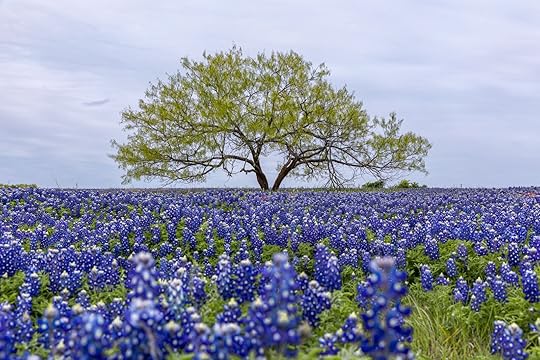
Photo: Christy berry/Shutterstock
What’s in bloom: Texas bluebonnets
When to go: Mid-March to early April
Spring in Ennis and Texas Hill Country is a spectacular time to visit as the rolling landscapes become blanketed in bluebonnets, Texas’ beloved state flower. From mid-March to late April, these vibrant blue wildflowers transform fields, highways, and meadows into breathtaking seas of color, making for some of the most picturesque drives in the state. Ennis, the “Official Bluebonnet City of Texas,” hosts the Ennis Bluebonnet Trails and Festival each April, featuring scenic driving routes, guided wildflower walks, live music, and local artisan markets. Meanwhile, the Willow City Loop near Fredericksburg and areas around Burnet, the “Bluebonnet Capital of Texas,” offer some of the best wildflower viewing in the Hill Country.
Fredericksburg has many beautiful Airbnbs to rent, some in town while others are closer to nature. The perk of staying here is that you’re also in wine country. Or you could head over to Marfa and stay at the artsy-and-retro-yet-somehow-futuristic El Cosmico. Airbnbs near Ennis are also available if you’d like the easiest access to the festival and the trails. 
The Story Behind One Epic Photo of the Stars in Saskatchewan, Canada
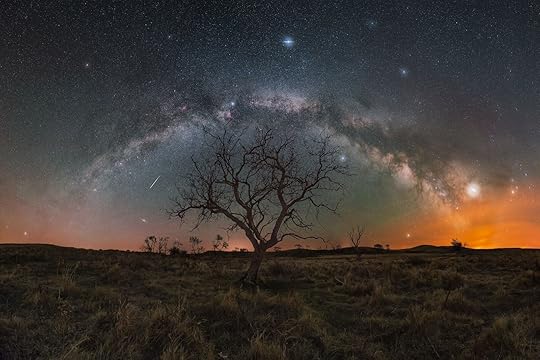
There was nothing casual about photographer Scott Aspinall’s journey to Nistowiak Falls in northern Saskatchewan. Armed with camera equipment, including a tracker that mimics Earth’s rotation to allow for long exposures, plus a survival kit for a night of camping in the wilds, he set out on a mission to capture the Milky Way.
Aspinall consulted the team at Churchill River Canoe Outfitters to help with his trip — a journey that involved crossing the rugged falls in a canoe to get the best possible photo and battling winds up to 34 miles (54 kilometers) per hour. A certain amount of luck was also required to get the right conditions for the shot, as is the case with all astrophotography adventures. In the end, his trip marked the first time anyone has snapped the Milky Way core from the east side of the falls.
“I have never worked so hard in my life for a photo,” says Aspinall of the experience.
That’s a big claim coming from a photographer who’s been shooting celestial scenes for almost a decade. Aspinall’s foray into night-sky photography started in the summer of 2016 when he says the sub-genre was gaining traction in the photographic community. A Saskatchewan native, he knew he “had access to some of the darkest skies in the world” and had often found himself fascinated by “questions about what was out there.”
“It all pointed to something much bigger than myself,” he tells Matador Network. “The ability of modern camera sensors and processing tools to answer some of those questions was addictive.”
Saskatchewan plays a big role in Aspinall’s photography, through which he not only aims to share the “wonder of the cosmos with viewers” but also challenge the stereotype that the province is “flat and boring.” Until his recent trip, however, Nistowiak Falls was one place that felt beyond his reach. In fact, he’d never ventured into northern Saskatchewan, which he describes as being less accessible than the province’s south.
And the epic shot that resulted from Aspinall’s journey to Nistowiak Falls? Well, that’s just one of many extraordinary scenes awaiting astrophiles — stargazers and shutterbugs alike — in exceedingly photogenic Saskatchewan.
ASTROPHOTOGRAPHY IN SASKATCHEWAN:WHERE TO FIND THE BEST PHOTO OPS
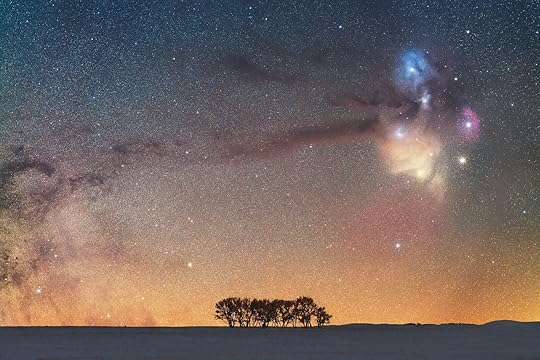
Photo: Scott Aspinall/Tourism Saskatchewan
Northern SaskatchewanNorthern Saskatchewan has almost 100 acres of wilderness for every person in the province. That spells tons of opportunities for nature photographers, including those with a love of the night sky. However, few locations are as picturesque and humbling as Nistowiak Falls.
Nistowiak Falls is one of the highest (and most famous) waterfalls in Saskatchewan. It cascades for 32 feet (10 meters) on the Rapid River, a short river that largely falls within Lac La Ronge Provincial Park. One of the province’s largest parks, Lac La Ronge is a wildlife-rich gateway to northern Saskatchewan, overflowing with natural beauty. The whole area is prime territory for photographers.
Another great place for photographers in northern Saskatchewan is Prince Albert National Park. With landscapes that span boreal forest, lakes, and wetlands, it’s a popular destination for fishing, hiking, and wildlife watching. One big reason to keep your camera handy in the winter months when the nights are longer: the northern lights. Due to their high latitudes, both Prince Albert National Park and Lac La Ronge Provincial Park make excellent backdrops for viewing the aurora borealis.
Southern SaskatchewanSouthern Saskatchewan has two parks that are well-known for astrophotography: Grasslands National Park and Cypress Hills Interprovincial Park. Grasslands is one of the last remaining intact prairies in North America. It has two distinct sides — badlands-esque East and prairie-centric West — which together are characterized by undulating valleys, dramatic canyons, eponymous grasslands, curving rivers, and rolling hills. A variety of wildlife populates the park, including bison, black-tailed prairie dogs, pronghorn antelope, coyotes, mule deer, and nearly 200 species of birds ranging from the threatened burrowing owl to the prairie falcon and eagles.
The sky above Grasslands has a Bortle Scale Class 1 rating for astro-snappers, meaning its night skies are as dark as night skies get. That makes it a breathtaking place to bag a photo of the Milky Way or the northern lights in the right conditions. Numerous hikes and drives crisscross the park, including the Two Trees Trail, the Belza plateau with its flat area for telescopes, the Ecotour Scenic Drive, and the 70-mile Butte hike. You could even catch an astro-oriented event such as Beyond the Big Dipper, a summer skywatching series facilitated by the Royal Astronomical Society.
The second southern Saskatchewan region to head for is Cypress Hills Interprovincial Park, which straddles the border of Saskatchewan and Alberta. An official Dark Sky Preserve and the highest point between the Rocky Mountains and the Appalachians, Cypress Hills is a patchwork of deep valleys, pine forests, and rolling hills where elk, deer, moose, pine martens, and cougars all make their homes (as do birds such as the red-tailed hawk and prairie falcon). Visitors can get to know the terrain on trails like the Hidden Valley Trail and Elkwater Lake.
Cypress Hills also has something particularly cool in store for astrophotographers: a Dark Sky Observatory and Dark Sky Campground. Moreover, it hosts an annual Saskatchewan Summer Star Party in August — one attendee even discovered a comet there in 2001.
ASTROPHOTOGRAPHY IN SASKATCHEWAN:HOW TO GET AN EPIC SHOT
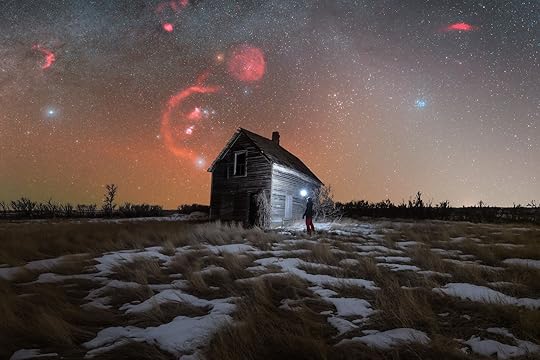
Photo: Scott Aspinall/Tourism Saskatchewan
Bring the right gearAspinall has three main gear tips for aspiring astrophotographers. The first is to make sure you have the right camera — specifically a DSLR or mirrorless camera with a lens that has an aperture of at least f/2.8. You’ll want it in “manual mode so you can adjust your shutter speed, aperture, and ISO.”
His second recommendation is to bring a headlamp with a red-light mode that allows you to see at night without damaging your night vision. “This means you’re able to enjoy the nice sky,” he says, “as well as shooting it.”
The third piece of equipment on Aspinall’s list is a tripod, “because your shutter speeds are going to be longer than you could possibly hand hold.” A tripod is invaluable to ensure your camera is steady enough to capture long exposures.
Set yourself up for successAs noted, setting your camera to manual mode gives you maximum control over both the exposure time and aperture. Specifically, you’ll want to set the aperture as wide as possible — f/2.8 or even f/1.4, if available — to allow in the maximum amount of light and capture stars in the distance.
Set your ISO to somewhere between 1600 and 3200 and work higher from there as needed. How much noise you get from the higher ISO will depend on the camera you have, so it’s good to try it out first and see the results. And don’t forget to shoot in RAW format to give yourself more flexibility in post-processing.
Consider bringing a remote shutter release or timer, which can help prevent camera shake when pressing the shutter button. A lens hood will protect the lens from unwanted light and minimize light flaring. And, of course, some extra warm clothes — such as hats, blankets, and gloves — are great for those nocturnal temperatures.
Practice, practice, practiceFor newer astrophotographers, it’s a good idea to practice before coming to Saskatchewan. The good news is it’s easy to build your skills outside in your local area or in a dark room. This will help you get used to where your relevant dials and buttons are, learn how to focus manually, and work out what’s involved in taking long exposures.
Ready, set, waitMore than anything, be sure to bring patience on astrophotography trips. So much about the art form is experimenting, and you’re guaranteed to have many failed shots before you bag your National Geographic prize winner. Luckily, in a place as beautiful as Saskatchewan, one of the most rewarding activities is simply sitting back and admiring the view. 
February 7, 2025
Ditch the Hotels: How to Rent a Campervan for an Easy Japan Ski Trip
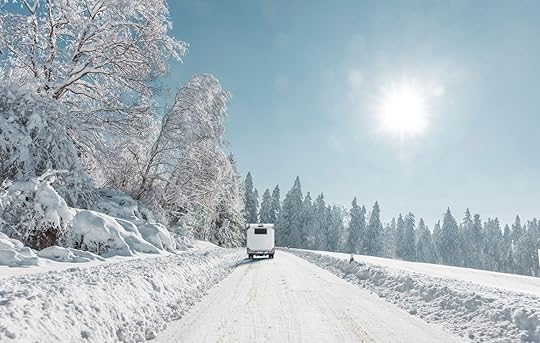
The campervan heater was blasting at full power, straining to keep pace with the winds outside that brought the temperature to well below freezing. With my thermal base layers on, I burrowed deeper into my sleeping bag, trying to find comfort in what felt like a mobile ice box parked in the snowiest place on Earth.
The rental company worker’s warning about the heating vent kept cycling through my mind: “Keep it clear of snow, or you’ll have a carbon monoxide problem,” she’d said cheerfully, pointing at the outlet barely a foot off the ground. Here in Hokkaido, Japan, getting more than two feet of snow overnight isn’t just possible – it’s routine. That’s why I’d set my alarm for the middle of the night to check the exhaust vent. But I kept jerking awake before it went off, filled with visions of my van slowly disappearing beneath a snowdrift.

The author’s relatively small campervan rental in Japan. Photo: Jacob Lewis
That was the first and, mercifully, coldest night of my weeklong Japan ski trip by campervan trip through the “Powder Belt:” a cluster of ski resorts in central Hokkaido famed for their abundant, dry, and powdery snow.
I was temporarily living in a Toyota Robinson B66, a roughly 17-foot-long campervan that claimed to sleep up to four adults. While that may be technically possible, it seemed like you’d need a Marie Kondo-level of discipline to squeeze your gear into the Honda Accord-sized space with more than two people. Still, the well-organized design packed in all the essentials. With a compact fridge, gas stove, and even a tiny TV, I had all the necessities in my mobile refuge — though the sink was purely decorative in winter. My snowboard fit satisfyingly well in the trunk, while the main cabin quickly became my space for drying gear, with my goggles, gloves, and outer layers dangling from every available hook and surface. It was less #vanlife and more “looks like a ski shop exploded in a sardine can.”

Renters get to park in hotel parking lots and use on-site amenities like spas and breakfast buffets. Photo: Jacob Lewis
But despite my complaints about frigid nights, this wasn’t roughing it on a bare-bones ski bum expedition. I’d signed up for Hoshino Resorts’ flexible new way to explore the Powder Belt on a Japan ski trip: a campervan package that includes mobile accommodations and access to the brand’s network of hotels and resorts. The package includes a weeklong lift pass for Furano Ski Resort, Hoshino Resorts Tomamu, and Kamui Ski Links, plus breakfasts and use of amenities at three different Hoshino resorts. Travelers can visit the three resorts in whatever order strikes their fancy, and since the campervan rental can be extended with extra days, it’s easy to add more stops (and slopes) to an itinerary. It seemed like the best of both worlds, offering the ability to chase the best conditions across central Hokkaido while still enjoying proper resort amenities like hot showers and hearty breakfasts.
From just outside Sapporo’s Chitose Airport, where I picked up the van, it was a straight shot on the Doto Expressway through Hokkaido’s winter wilderness to my first stop, Tomamu. In Hokkaido, ski resorts rise straight from the snowy plains, with no steep ascents required. The highway was pure packed snow, but unlike the white-knuckle hairpin turns of the French Alps or the oxygen-starved passes of Colorado, Hokkaido’s lower elevation and gentle roads were much easier to drive on. My van’s gutsy 2.6-liter engine, chunky snow tires, and four-wheel drive design seemed able to keep pace with locals driving 20 miles per hour over the speed limit, and it wasn’t long before I saw lifts appearing through the snowfall.
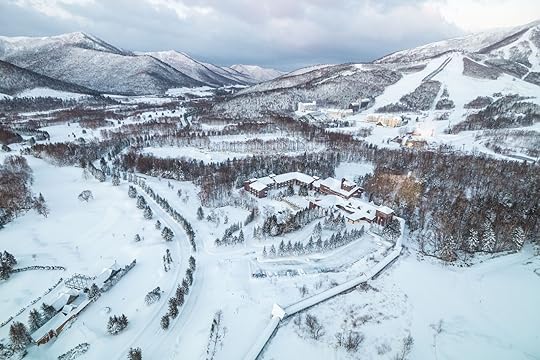
Photo: Bookzv/Shutterstock
In Tomamu, an overnight powder dump had delivered the goods. The dual-mountain resort has one of Hokkaido’s largest slopestyle parks, but the real fun lies in its tree runs. The perfectly spaced birch forests create natural halfpipes and hits, while the resort’s Experts Only Powder Areas show serious commitment to safety. The resort has a Yukiyama app with GPS tracking and ski patrol communication that off-piste skiers in the expert zones are required to have. It’s a reassuring presence when hunting for fresh tracks in the deeper woods.
My mornings at Tomamu started with a shower at Mina Mina Indoor Beach (Japan’s biggest indoor wave pool), followed by breakfast at Forest Restaurant Nininupuri. The Japanese word for buffet translates to “Viking,” which perfectly describes the epic spread. Each day, I started with fuwa fuwa (meaning “impossibly fluffy”) French toast.
Ski-in, ski-out dining was available throughout the day on the resort’s Hotalu Street near the base, where quick-serve offerings like ramen, hotpot, and even a steakhouse helped maximize my time on snow. Between laps, I’d duck into the hotel lobby for free-flowing coffee or even sparkling wine, making campervan life feel more like glamping than roughing it.
Tomamu’s six lifts and 29 runs kept me thoroughly entertained for two days, but the icy, open road beckoned. The route to my next stop, Furano, traded highways for byways, as Google Maps directed me through increasingly questionable rural shortcuts. I found myself navigating narrow lanes between towering snowbanks, earning bemused looks from a farmer and his Shiba Inu as I executed a careful multi-point turn.

The Furano Base Area on a sunny winter day. Photo: Jacob Lewis
As I pulled into Furona’s base, I saw three blonde women with braids unfold themselves from a beat up kei car – a tiny vehicle that qualifies for lower taxes in Japan. I learned they were Swedish and had driven all the way from the Niseko ski resort where they worked for a ski weekend. “Niseko is our favorite place on Earth,” one told me, “but the mountains here are pretty incredible.”
They weren’t wrong. Unlike Niseko’s gentle rollers, Furano brings the drama like a Japanese brown bear with something to prove. Its rugged peaks command attention, with immaculately groomed pistes that give way to expert tree runs.
But despite that, I found myself grumbling about my fortunes under the brilliantly blue sky. Friends had been sending videos from Hakuba (in the Japanese Alps, closer to Tokyo), where they were drowning in a record-breaking January dump of more than nine feet. I complained of my awful luck to a chairlift buddy, a local skier who sported a nicotine-stained smile. He dismissively waved his hand toward Mt. Tokachi and the Daisetsuzan Range beyond. “Lived there 50 years ago,” he said. “Furano’s better. Less crowded, better views.” His knowing grin and weathered face suggested he’d seen enough winters to make that call.
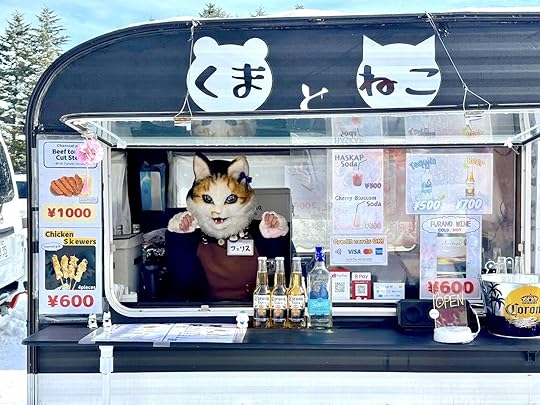
The quirky Kuma to Neko food truck. Photo: Jacob Lewis
Still, with the gondolas packed with Australians and other English speakers, it was easy to forget what country I was skiing in. That made me extra glad to find that Furano’s base area was a wild fever dream of wacky Japanese tastes. A food truck called Potato Gang was hawking mochi and potato croutons swimming in thick gravy, while next door, a woman in full cat cosplay was serving up surprisingly tender beef tongue steaks and homemade haskap berry soda from a van called Kuma to Neko (“Bear and Cat.”) With my tastebuds utterly befuddled but hunger sated, I called it a day and drove the hour and a half further north to Asahikawa.
Pulling into a downtown parking lot at dusk, Japan’s coldest city announced itself with the “kaw-kaw” sound of massive crows – the unofficial soundtrack of Japan’s northern cities. I parked my van beneath their jeering chorus and ducked into the OMO7 Asahikawa hotel, making a beeline for Sauna Plateau, the hotel’s retro, Nordic-inspired bathhouse. Following onsen tradition, I joined the other naked soakers in washing away the day’s adventures.
Wrapped in the hotel’s cozy yukata, I discovered the lobby to be a powder-chasers’ Mission Control. Fellow riders from around the globe huddled around a wall of live webcams, tracking conditions at surrounding resorts. Others hovered over the communal wax bench, sharing tales of the day’s finds while tuning their boards.
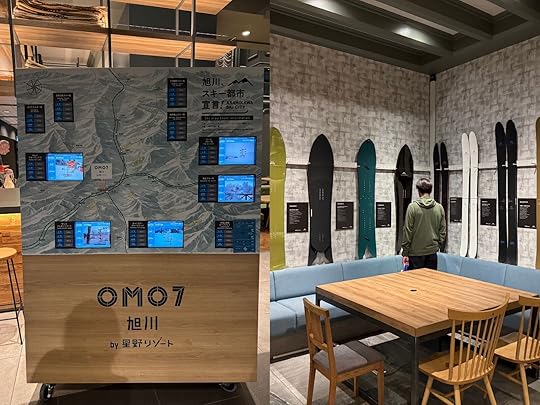
Scenes from the OMO7 Asahikawa hotel lobby. Photo: Jacob Lewis
Asahikawa’s unique geography makes it a snow magnet, sitting in a natural basin surrounded by the Daisetsuzan Range to the east and the Kitami Mountains to the north. Cold air from Siberia funnels into that basin, producing some of the driest, lightest powder in Japan, even by Hokkaido standards. The webcams in the lobby make it easy to learn which area resorts are scoring the best snow, and fortunately, there are several nearby. The surrounding hills have everything from serious backcountry terrain to family-friendly slopes (such as Canmore Ski Village, where a four-hour adult lift pass can be as low as 500 yen, or about $3.20). The closest resort to the hotel, Santa Present Park, is just 10 minutes away.
The next morning, armed with the latest intel, I set out for Kamui Ski Links, just 30 minutes from downtown and the final resort included on my lift pass. I quickly learned why the six-lift, 25-run resort is becoming a powder hound’s worst-kept secret. Kamui’s relaxed attitude toward off-piste riding makes it a backcountry favorite, with abundant gates marking legal entry points into the trees. The terrain varies from mellow glades perfect for beginners to steeper chutes to challenge expert riders. After a white-out morning that gave me the slopes mostly to myself, the clouds parted to reveal the full sweep of central Hokkaido – an endless sea of evergreens rising and falling across ridgelines.
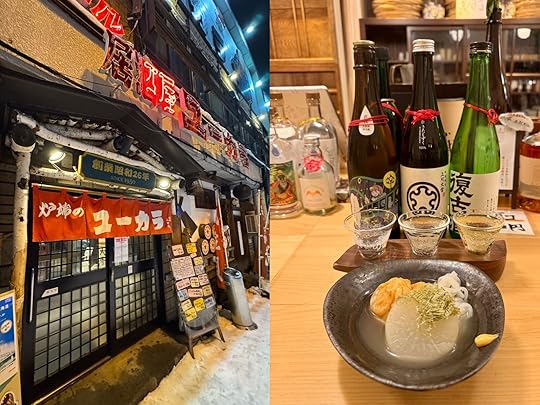
A night out in Asahikawa. Photo: Jacob Lewis
Back in town, I lost myself in Asahikawa’s after-hours scene. I started at Yakitori Dojyo Yoshiya, a fourth-generation yakitori joint where they still calculate checks on an abacus, and the secret sauce recipe dates back 90 years. The city’s menus lean heavily into Hokkaido specialties, such as Genghis Khan (grilled lamb), local venison, and even bear meat.
Later, I found Freehouse The Yeast, where the craft beer selection could go toe-to-toe with any trendy brewery in Portland or Copenhagen. I rounded out the evening at Washu Kakuuchi Uedaya, a standing-room-only bar hidden behind a fridge in a sake shop, where draft sake and homemade oden (veg and fish cakes simmered in broth) warmed my bones before I returned to my van and cozy sleeping bag.
By my last day, the paradox of doing a Japan ski trip via campervan had become clear: you either get ideal weather for skiing and riding, or ideal weather for camping — but not both. I got the latter, and my last day ended in another bluebird day without a flake of fresh snow. There was no need to dig the van out, but no fluffy stuff to surf in, either.

The author with his campervan rental for the week. Photo: Jacob Lewis
I switched from powder hunting to onsen hunting that day, pointing my trusty Toyota to the mountains east of town to a newly minted masterpiece: the Kitoushi no Mori Kitoron hot springs complex. It was designed by the acclaimed architect behind Tokyo’s Olympic Stadium, with locally sourced larch wood on the exterior and plenty of glass windows looking out on the hillside and farms below. Inside, the roomy spaces were adorned with birch wood and bespoke furniture crafted by local artisans, creating an environment that felt both luxurious and authentic to Hokkaido.
As I soaked in the mineral-rich waters drawn from the Daisetsuzan Range, watching steam rise against the winter sky, it was clear that there’s more to Hokkaido’s “Powder Belt” than just finding perfect snow or checking resorts off a travel list. Having a campervan as a base for my Japan ski trip gave me the freedom to follow what each day brought on a whim, whether that was chasing powder to get first tracks through a forest, finding a secret sake bar, or simply hitting the road to soak in a local hot spring while I waited for the next storm to roll in.
If you book an international flight to Japan with Japan Airlines (JAL), you can add domestic flights throughout Japan at a fixed low price via the Japan Explorer Pass. It allows you to fly from Tokyo to more than 30 cities, including Sapporo, for as little as 7,700 yen (or about $50).
Campervan rentals for a Japan ski trip via the Hoshino Resorts Powder Belt package start at $1,419 per vehicle for four nights/five days. It includes use of a campervan with snow tires and a highway toll pass, basic insurance, a five-day lift ticket good for access at three different resorts, and breakfasts and hotel access at nearby Hoshino-owned resorts. 
The 13 Newest Additions to the Official ‘Most Beautiful Villages in Italy’ List
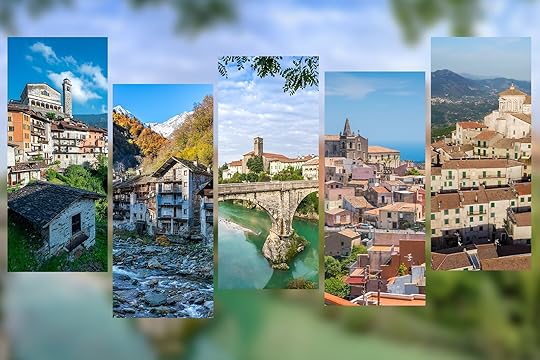
In 2002, a group of mayors in Italy founded the non-profit association I Borghi più belli d’Italia to promote and revitalize the country’s small, rural towns and their history. The name of the association says it all: “The Most Beautiful Villages in Italy.” The mission is to enhance and promote the beauty, quality of life, and the historical, artistic, and cultural heritage of some of Italy’s lesser-known villages, or borghi, that have a population of under 15,000 people. And in doing so, attract tourists and new residents to help rejuvenate those borghi.
“The feedback we have is very positive throughout Italy,” says Monica Gillocchi, head of communications and international relations for the association. She adds that the average annual tourist growth for villages is about 8 percent after being admitted.
To date, 940 villages have been evaluated since 2002, Gillochi says, and 375 carefully selected towns have received the coveted label. Forty of those have at least one UNESCO heritage site. As of writing, 98 towns are waiting to be evaluated, but only 30 are on the evaluation schedule for 2025. Only a small portion of those will make the list.
There are four impartial evaluators working for the association. Borghi are assessed on 72 parameters on a 110 point scale, and those that score 79 or higher are admitted. In 2024, 13 of the 32 evaluated villages made the cut.
These are the newest additions to Italy’s official list of the pretties small towns and villages.
We hope you love the hotels and Airbnbs we recommend! Just so you know, Matador may collect a small commission from the links on this page if you decide to book a stay.
Cividale del Friuli, Friuli Venezia Giulia
Photos: milosk50/Shutterstock and xbrchx/Shutterstock
Founded in Roman times, Cividale del Friuli has a population of about 11,000 people and is located on the banks of the Antisone River in northeast Italy, close to the country’s border with Slovenia. Stroll Cividale del Friuli’s cobbled streets and pretty squares to see its landmarks: the 14th-century cathedral of Santa Maria Assunta; the UNESCO-listed Lombard Temple built in the eighth century; and, the village’s most recognizable monument, the 15th-century Devil’s Bridge.
Where to eat: The beautifully decorated, Michelin-recommended restaurant Al Monastero is a good place to try local pork specialties and regional wines made from picolit and friulano grapes.
Where to stay: A five-minute drive from the village center, this 19th-century farmhouse has been renovated into a charming apartment on an olive oil farm. You can walk the surrounding land planted with olive trees and vines, and pet the resident horses.
Spilimbergo, Friuli Venezia Giulia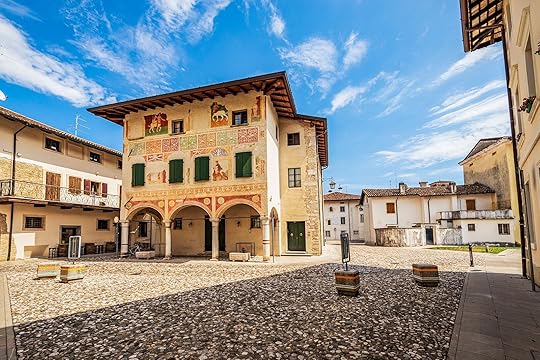
Photo: Alberto Masnovo/Shutterstock
Spilimbergo, located along the banks of the Tagliamento River in northeastern Italy, is one hour west of Cividale del Friuli. Take in the medieval houses that line the streets before stopping at the Mosaic School of Friuli, an art school like no other and the town’s claim to fame. Inside, there are more than 800 magnificent mosaic works on display, and you can see the students and their teachers at work. The cathedral of Santa Maria Maggiore and its 14th-century frescoes is a must-see, along with the hilltop castle and its 15th-century Palazzo Dipinto’s colorful facade.
Where to eat: La Torre serves regional cuisine with a modern twist within the elegant medieval castle of Spilimbergo.
Where to stay: Casa Antica Pietra Spilimbergo is a beautifully decorated and well-equipped one-bedroom apartment in the heart of Spilimbergo.
Bagolino, Lombardia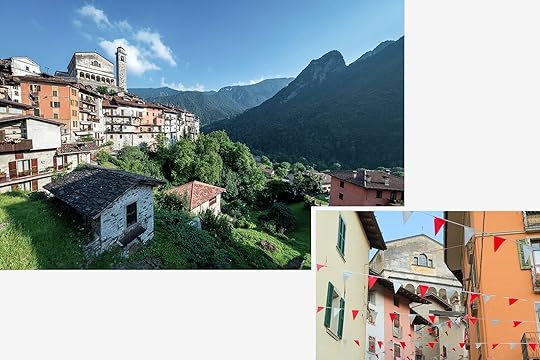
Photos: Steve Pez/Shutterstock and Fabio Caironi/Shutterstock
Bagolino is a small, scenic town in a valley in the Southern Alps of northern Italy. At the top of the medieval village is Bagolino’s most famous monument: the impressive Church of San Giorgio, where the frescoed vault and walls will leave you in awe. Visit in early March to attend the town’s 500-year-old carnival that fills the streets with music and costumes for two days, or come in mid-October for the two-day Transhumance Festival that celebrates the local cows and goats as they return to their sheds for the winter after a summer spent grazing the pastures. Less than 15 minutes from Bagolino is beautiful Lake Idro where you can swim, and Val Sabbia and its ski resort are only 30 minutes away.
Where to eat: For a taste of the locally made Bagoss cheese, along with local wine and cold cuts, head to La Malga del Re in the town center.
Where to stay: Casa Cerí is a modern two-bedroom apartment that will place you in the heart of the small town.
Rassa, Piemonte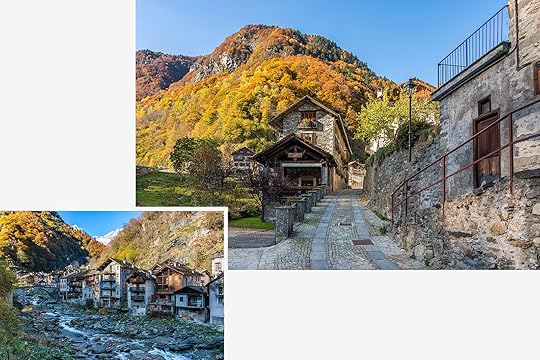
Photos: essevu/Shutterstock and essevu/Shutterstock
The picturesque village of Rassa, with its traditional geranium-adorned stone chalets, is located along the fast-flowing Sorba River in the north of Italy near the Swiss border. Walk across the stone bridge that spans the river and take in the remote village of fewer than 100 people. The Ecomuseum, housed in a water-powered sawmill, is a must-see. Visit during the Blueberry Festival (Sagra del Mirtillo) that takes place every year in August to celebrate the fruit harvest with the locals, buy artisan crafts, and taste the famous local grappa.
Where to eat: Locanda delle Alpi, here since the 18th century, is a tavern where you can try a variety of regional specialties, many of which include cheese.
Where to stay: Rent an entire two-bedroom traditional chalet with a view of the river and the stone bridge for a total immersion in Rassa.
Ceriana, Liguria
Photo: monticello/Shutterstock
The medieval hilltop village of Ceriana is located in the northwestern part of the country near the border with France. Walk the small town’s narrow alleys to see its landmarks, including the Parish Church of Saints Peter and Paul and its stunning baroque interior, the 18th-century Roverizio Di Roccasterone Palace, and the four oratories (chapels) whose fraternities are pillars of the community’s festivals and day-to-day life. Visit on the third Sunday of August to take part in the town’s yearly pork sausage festival during which all four fraternities make their own salciccia.
Where to eat: Family-run Trattoria La Piazza di Ceriana serves affordable, classic Italian food, including pizza.
Where to stay: Rent a unique five-floor, two-bedroom medieval house in the center of Ceriana.
Bertinoro, Emilia Romagna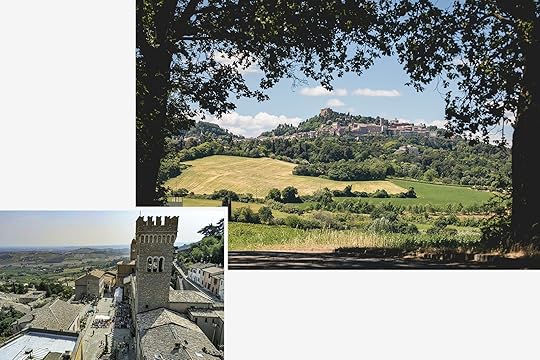
Photos: I Borghi più belli d’Italia
Located on a small hill, the medieval town of Bertinoro has two nicknames: the Balcony of Romagna and the Town of Wine. The first nickname is inspired by the amazing views of the neighboring countryside, the second comes from the albana and sangiovese vineyards that grow on the surrounding hills. La Rocca, a 1000-year-old castle that houses 17th-century frescoes, is the town’s most famous monument, but the 14-century Palazzo Ordelaffi, the current town hall, is a strong contender. Visit the first Sunday of September for the Festival of Hospitality, an 825-year-old tradition.
Where to eat: Da Nonna Rina serves handmade pasta, as well as other regional specialties, alongside local wines.
Where to stay: Hotel Panorama is a charming little hotel in the center of town with great views.
Mulazzo, Toscana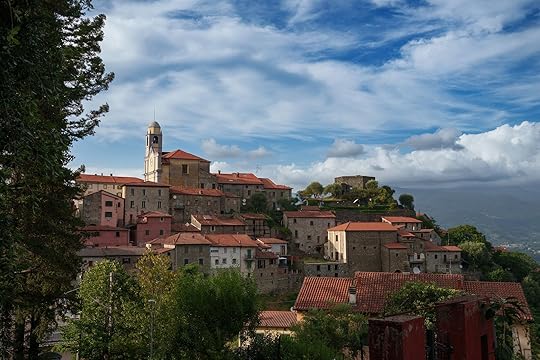
Photo: Claudio Giovanni Colombo/Shutterstock
Mulazzo is a tiny village of stone houses and cobblestoned streets at the end of a long and windy road in Tuscany’s Lunigiana mountains. Walk Mulazzo’s narrow streets to get a feel for this ancient village and catch elevated landscape views. Every August, Mulazzo celebrates local wines and products — including chestnuts, olive oil, honey, and cheese — during the Bancarel’VINO Award event. Just 15 minutes from Mulazzo is Montereggio, a village that book salesmen made a center of literature for centuries. Every year in July, the village hosts a book festival.
Where to eat: Locanda il Rustichello serves traditional local cuisine and wine with amazing views in a serene setting.
Where to stay: This two-bedroom home at the edge of a chestnut forest is full of traditional charm and has a lovely garden with a large orange tree.
Ripatransone, Marche
Photos: I Borghi più belli d’Itali, lucio pepi/Shutterstock, and pio3/Shutterstock
The beautiful hilltop town of Ripatransone, known as the Belvedere of The Piceno for the panoramic views of the surrounding rolling hills, is home to the narrowest alley in Italy. Once you’ve attempted, and possibly succeeded, to squeeze through this 14-inch passageway, visit the beautiful Luigi Mercantini Theater located on the second floor of the Palazzo del Podestà cathedral and the town’s fortifications.
Where to eat: Agriturismo Iervascio is a farm run by two brothers that serves simple, yet delicious, food and wine.
Where to stay: This two-bedroom apartment with a rooftop terrace is located right in the center of town and offers beautiful views.
Scheggino, Umbria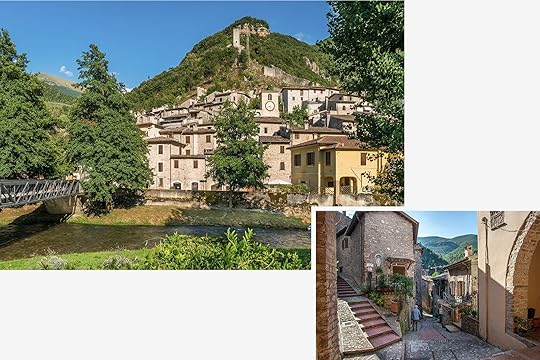
Photos: essevu/Shutterstock and Lorenzo Dottorini/Shutterstock
Scheggino is a small and charming hilltop town located on the bank of the Nera River. Walk the cobblestoned streets, including the subterranean passageways, to admire the traditional stone houses before stopping at the 13th-century Church of St. Nicholas with detour-worthy frescoes. The Spring of Valcasana, where incredibly clear water flows out of a stone fountain, is a quiet place to take a stroll among the trees and look at fish and waterfowl.
Where to eat: Antico Grottino in the town center is a small, rustic restaurant that serves delicious local dishes alongside regional wines.
Where to stay: The Torre Del Nera Albergo Diffuso & Spa offers guests beautiful accommodations with wood stoves, spa amenities, and exceptional views from its terrace.
Capranica Prenestina, Lazio
Photos: ste77/Shutterstock and essevu/Shutterstock
The medieval village of Capranica Prenestina, perched at about 3,000 feet elevation in the Prestini Mountains, is said to be the highest in the region of Lazio. Walk the steep streets of the village to the Church of La Maddalena and its impressive dome, and stop at Piazza Pietro Baccelli to take in the magnificent views. Capranica Prenestina is surrounded by chestnut groves, and during the fall chestnut festival you can sample a wide range of things made with the nut. An annual blackberry festival also takes place at the end of summer.
Where to eat: Taverna Hieronymus is a small and simple restaurant where you can dine on Italian specialties at the same table as the locals.
Where to stay: While there are no hotels or Airbnbs in the village, B&B Casale delle Grenestre in the nearby town of Castel San Pietro Romano is just 15 minutes away. The charming stone farmhouse has a pool with great views of the surrounding landscape.
Introdacqua, Abruzzo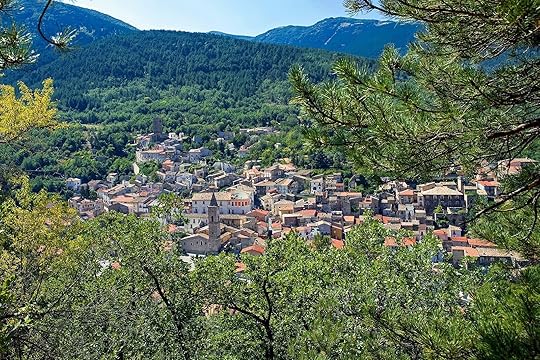
Photo: Gimas/Shutterstock
Introdacqua is a medieval walled town worth exploring, located deep in the Peligna Valley and surrounded by woods populated by brown bears, wolves, and deer. You can while away an entire day walking the streets of the village and checking out its access gates in the fortifications, the Church of SS. Annunziata and its frescoes, and the medieval tower Dongione of Introdacqua. Gentian liqueur is a local specialty, so make sure you give it a try.
Where to eat: Ristorante AnimA is owned and run by two brothers who combine contemporary cooking with high-quality local ingredients.
Where to stay: This one-bedroom home located just outside the town has a large garden and views of the mountains.
Forza D’Agrò, Sicily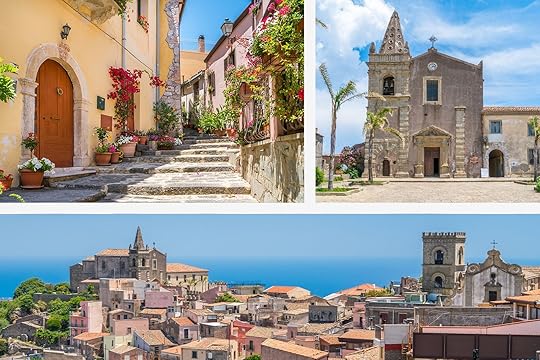
Photos: essevu/Shutterstock, essevu/Shutterstock, and essevu/Shutterstock
Forza D’Agrò is a hilltop town located between Messina and Taormina on the island of Sicily. While the town has many draws — views of the Ionian Sea, an historic monastery, and many palazzos and churches — it is perhaps better known as one of the filming locations for The Godfather.
Where to eat: Trattoria Anni 60 serves traditional Sicilian dishes and offers amazing views of the coastline and the sea from its terrace.
Where to stay: This two-bedroom house provides travelers with the charm of typical Sicilian homes, as well as amazing views of the coast and the mountains from its patio.
Gravina, Puglia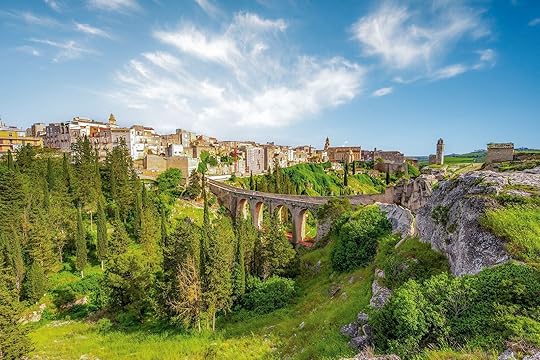
Photo: zedspider/Shutterstock
The ancient walled town of Gravina is located between a hill and the edge of a ravine in southern Italy. The main landmarks include the aqueduct bridge, which was one of the filming locations for the James Bond movie No Time to Die, as well as the San Michele delle Grotte, an impressive church carved into the rock. Be sure to also try the regional Gravina wine during your visit.
Where to eat: 13 Volte Luogo e Gusto is a cave restaurant that serves traditional local dishes.
Where to stay: This one-bedroom apartment has some unique architectural features and offers beautiful views of the city from its high vantage point. 
February 6, 2025
Take It From an Expert: How the Couple Behind ‘Adventure Fix’ Will Inspire You to Take Your Next Truly Special Trip
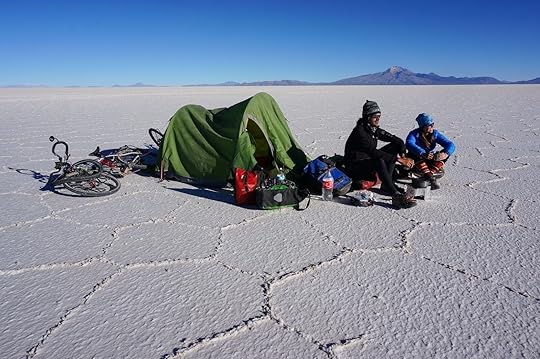
For the past decade, Amanda Zeisset and her husband Antonio Cala have been living what many travel writers and photographers only capture through their content. They’ve traveled to more than 150 countries, always with adventure at the top of the itinerary: a 15,000-plus mile cycling trip from California to Patagonia, 10,000 nautical miles through the Caribbean and Sea of Cortez, an 18,000-plus mile motorcycle expedition across West Africa. The list goes on.
Through their newsletter Adventure Fix and adventure tour booking platform Adventure Fix GO, they’re inspiring others to do the same. Each week, the newsletter highlights remote destinations, wildlife encounters, and expeditions through some of the most engaging stories, photography, and video published online. Importantly, it also has the information people need to take a similar trip of their own.
I’ve long been a subscriber, and often find myself sucked into stories and dreaming up new journeys. I recently connected with Cala and Zeisset to learn more about how they have built up an independent travel media business, what makes a great travel story, and the importance of getting out in the world.
This interview has been edited for length and clarity.

Hiking Huayhuash Circuit in Peru. Photo: Amanda Zeisset
Matador Network: What made the adventure travel media niche attractive to focus your business around?Amanda Zeisset: My first business, The Adventure Junkies, began as an adventure travel blog that my husband and I co-authored. Over time, it evolved into an outdoor gear review website. Despite its success, my true passion was in travel experiences and destinations. When the opportunity came up to dedicate our time to a new business venture, we considered several niche ideas but we weren’t ready to leave the adventure travel space.
We had spent over a decade exploring the world, first by bicycle, then by sailboat and then our last big journey was by motorcycle. In between these trips, we used our savings to go to far-off places to hike, dive, and kayak.

Photo: Amanda Zeisset
As the saying goes, write what you know — and after so many years seeking out adventures, I was confident we could bring a unique perspective to the space.
Travel media, and media of all kinds, has gone through a lot of shifts in recent years. What problem do you see Adventure Fix solving for people interested in engaging adventure travel stories?There is so much travel content online so we help our audience weed through the noise and find truly special trips. Our target audience are experienced travelers who are looking for their next great adventure, so we feature destinations and experiences that are off the radar for most people.
For us and our readers, traveling isn’t about relaxing on the beach or taking a selfie with a famous monument in the background, it’s about going to places that feel like stepping into a new world. It’s about experiencing our planet in a meaningful way—whether that means making eye contact with an orca while snorkeling in Norway, staring up at K2 after spending a week walking to the base camp, or stargazing while camping on a secluded island in Palau.
Your curation shows how deeply and widely you read. How do you find the stories that you spotlight? What makes for an exceptional travel story?Some of the most interesting finds have come from when I’ve gone down a deep, deep rabbit hole. Usually, it starts with something in my YouTube or Instagram feed and hours later I have so many tabs open that my laptop starts to overheat.
I’ve never been overly passionate about one thing, but I’m very curious about a lot of different topics. So I attempt to find connections between my current interests and what might captivate our readers. My goal is to balance giving readers what they signed up for with surprising them. The idea is to create content that makes them eager to open each edition, hoping to discover a hidden gem.
For our main features in the newsletter, I start with a destination or experience in mind and then find supporting articles and videos. The ones that make the cut do the best at showing the place or trip in the most engaging yet realistic way. That means exceptional photography and descriptions while not going overboard on editing or hype.
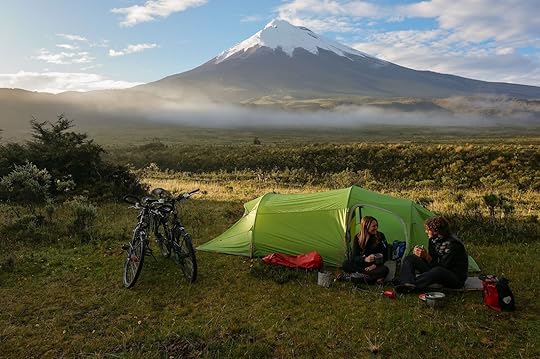
Amanda Zeisset and Antonio Cala camping at Cotopaxi. Photo: Amanda Zeisset
What is more important: the destination, or the way that a story is told?The destination, without a doubt. Adventure Fix is designed for action-takers, not armchair explorers. While we occasionally feature first-person documentaries, films, or blogs, our primary focus is on delivering practical insights for real travel adventures.
To be featured in our newsletter, the adventure or destination must be inherently captivating. We write for people who aspire to create their own stories, rather than staying at home and living vicariously through someone else’s narrative — which most times is exaggerated to grab attention.
How has the definition of a “good story” changed over time as social media and video have become primary platforms for these stories?As a destination-focused newsletter, I look for videos, shorts, and articles that truly showcase the place or experience. The content must give our readers an idea of if the destination or adventure is right for them, or not.
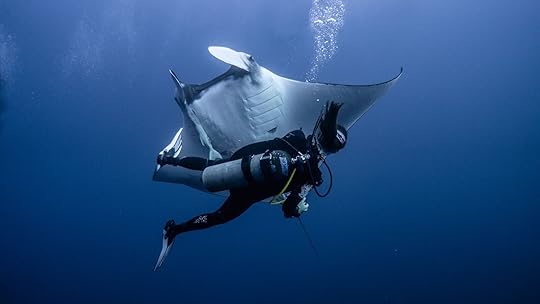
Diving with giant mantas near Mexico’s Revillagigedo Islands. Photo: Amanda Zeisset
For us, a “good story” is genuine and unique. It should be so special and interesting that you don’t need to hype it up or use click-bait titles, or girls in bikinis, to get people to read. Simply mentioning the place or experience should be enough to excite our audience.
Do you have three travel stories that stood out most to you last year?Our feature of Ratua Private Island Resort got a lot of attention. It’s a place that has that special blend of comfort and authenticity. There’s something for everyone, from diving the reefs, hiking in the forest, or kayaking along the coast.
The main story in Issue 171, Surfing Hippos, highlighted an extraordinary safari experience in Gabon. Despite being a challenging destination to reach, the unique wildlife encounters made it unforgettable.
Another adventure that stood out was Kayaking the Rock Islands of Palau. We featured it two years ago in an issue and recently did what we call a “deep dive,” which is a more detailed look at the experience and how you can do it yourself.
Who do you follow that inspires you and helps you do your job?A lot of my inspiration for trip ideas comes from tour companies like Big Fish Expeditions and Southern Sea Ventures. One of my favorite independent creators is Viktor Posnov.
What are some of the biggest challenges of being an independent travel media worker today?As a business owner, one of the biggest challenges is finding product-market fit. It’s essential to create unique, engaging content that captures attention without resorting to clickbait or shortcuts, even if it means slower growth.
Maintaining audience trust and respect is crucial. It’s easy to chase trends, but in the long run, having a distinct personality and connection with the audience is what will set you apart.
In what ways has technology made travel media jobs more accessible and dynamic? Lots of words spent on how technology has negatively impacted storytelling, but are there positives as well?Absolutely, there are plenty of positives. Perhaps the biggest is global reach. As an individual, you can share your message with anyone in the world who has internet access, without needing traditional gatekeepers like publishers or TV networks. That alone is huge.

Amanda Zeisset in Gembu, Nigeria. Photo: Amanda Zeisset
The way people consume content has also transformed the experience. While traditional blogs and magazines still hold value, not everyone wants to read long, wordy articles. Platforms like YouTube, Instagram, and TikTok offer bite-sized, immersive content — short videos, posts, and reels — that quickly engage viewers.
Smartphones, fast internet, and social media have democratized content creation. Independent creators can now build their own audiences, secure brand partnerships, and monetize through ads. Technology also makes it easy for audiences to save and act on content, book trips or buy products directly from their devices.
What are the emerging trends in adventure travel that you see shaping both the way that people travel and how they engage with travel stories?The biggest trend that’s on my radar is people seeking out experiences beyond the usual guide book spots. Everyone has heard about hiking the Inca Trail to Machu Picchu and diving the cenotes in Mexico. I see more and more people looking to go to remote places and have unique, extraordinary experiences.
Adventure Fix is designed with these travelers in mind — those who have “been there, done that” and are now craving deeper, more authentic adventures. We aim to connect our readers with unique journeys that offer something truly special and unforgettable. 
To learn more, sign up for the Adventure Fix newsletter.
More like thisTravel10 Travel Apps Matador's Editors Actually UseA Luxury Sleeper Train Between LA and SF Is Coming by 2028. Here’s What to Expect.

Train travel has surged in the past few years. Maybe it’s because people are wanting to travel more sustainably, or because riding the rails is a more romantic way to explore the world than flying. Whatever the reason, ridership numbers don’t lie.
Eurail sold 1.2 million passes in 2023, the most purchased since the concept was created in 1959. In late 2024, Amtrak announced its biggest year on record with 32.8 million riders that year, a 15 percent growth from 2023 — perhaps no surprise with new routes and restored older routes. Brightline, Florida’s high-speed train service, recently extended from Miami to Orlando, and has plans for a 200-mile-per-hour train that will eventually link Las Vegas to Southern California.
But it’s Dreamstar Lines, a private passenger rail company based in California, that is bringing a luxury sleeper train that would link Los Angeles to the Bay Area. The route brings back something the area hasn’t seen in more than half a century — the last overnight passenger train between LA and SF ran in 1968, when the Lark stopped operating.
The start of Dreamstar Lines
Photo: Dreamstar Lines
Dreamstar Lines cofounder and chief strategy officer Thomas Eastmond was inspired to start the company after frequent trips between Los Angeles and San Francisco for his work as an attorney, Joshua Dominic, Dreamstar Lines CEO, says in an email.
“After one 3:00 AM flight out of LAX too many, arriving for an all-day deposition feeling like he’d already put in a full day’s work, Thomas wondered if an overnight train might be an option,” Dominic says. “After learning all the reasons why there was no such service, he finally came to the conclusion that if he wanted to ride this train, he and his partners would have to build it themselves.”
Dreamstar Lines was founded in 2016, and Dominic became CEO in 2024. That year, Dreamstar signed a memorandum of understanding with Union Pacific Railroad to operate trains on its tracks. The launch date of the rail service has been pushed several times, but the hope is for the trains to be running before the Summer Olympics in Los Angeles in 2028.
“Running a railroad really takes three things: You need tracks to run on, trains to run, and people to run the trains. There are many moving pieces, and coordinating across various stakeholders takes time,” Dominic explains.
What will riding on board Dreamstar Lines be like?Dreamstar Lines will only operate at night, and link Los Angeles and the San Francisco Bay Area in about 10 hours. Comfort is of top priority. Dominic described the basic tier experience in a press release as “equivalent to an international first class flight or a Jet Blue Mint Suite.” The sleeper cars, on the other hand, “are designed for relaxation and incorporate circadian design principles supporting a good night’s sleep.”

Rendering of the lounge. Photo: Designworks / Dreamstar Lines
Each Dreamstar Lines train will include a lounge for passengers to socialize and enjoy a drink and a snack. The sleeping accommodations will range from lie-flat seats to private rooms with bathrooms and showers that can sleep two to six people. Recent renderings created by Designworks for the luxury overnight train service suggest coziness and sophistication in a serene decor.
 Rendering of the Suite accommodation that sleeps two, and features a queen-size bed, as well as a bathroom with a shower. Photo: Designworks / Dreamstar Lines
Rendering of the Suite accommodation that sleeps two, and features a queen-size bed, as well as a bathroom with a shower. Photo: Designworks / Dreamstar Lines Rendering of the Standard accommodation which includes a semi-private lie-flat seat. Photo: Designworks / Dreamstar Lines
Rendering of the Standard accommodation which includes a semi-private lie-flat seat. Photo: Designworks / Dreamstar Lines Rendering of the Family accommodation which sleeps six and has a private bathroom and shower. Photo: Designworks / Dreamstar Lines
Rendering of the Family accommodation which sleeps six and has a private bathroom and shower. Photo: Designworks / Dreamstar Lines Rendering of the Bedroom accommodation which sleeps two and has a private bathroom and shower. Photo: Designworks / Dreamstar Lines
Rendering of the Bedroom accommodation which sleeps two and has a private bathroom and shower. Photo: Designworks / Dreamstar LinesWhile the Dreamstar Lines trains will look nothing like those operated by Amtrak, there will be one similarity. Like with Amtrak’s Auto Train, Dreamstar Lines will allow passengers to bring their cars on board the train, making the transition between the train station and the final destination much smoother.
The luxury sleeper train service operated by Dreamstar Lines will run seven days a week in both direction. The trains will reach a top speed of 79 mph, and make few stops near the endpoints in order to prevent disturbance for sleeping passengers. 
In Ritzy Scottsdale, The Global Ambassador Is a Hotel Fit for Royalty

Iconic restaurateur Sam Fox isn’t just a “culinary conceptualist” anymore — now, he’s also a hospitality innovator. With the conception and successful launch of his first hotel property, The Global Ambassador in Scottsdale, Arizona, Fox is ushering in a new era for blending independent food, beverage, and hotel concepts — one that’s delicious in design and cooking delicacies. The 141-room hotel, with rooms from around $400 per night depending on season, is part of the Preferred Hotels & Resorts Legend Collection, signifying its luxurious status as this collection only includes the “best of the best” for exceptional global hospitality.
When I had the chance to spend the night at the property for a “media rate” while visiting town for a family gathering, I didn’t hesitate to jump at the opportunity to check it out because, at that point, I’d heard about how impressive this place was from multiple relatives, for many months.
Traveling in Arizona? Check out Matador’s Arizona accommodations guides: 11 Phoenix Airbnbs With Luxury Pools, Putting Greens and Artsy Vibes Phoenix airport hotels that put you close to your flight and the entire city These Large, Family-Friendly Airbnbs in the Southwest Make the Perfect Holiday Getaway 12 top-rated Airbnbs in Tucson for a charming southwest adventure The Best Airbnbs in Scottsdale, Arizona, for a Bachelorette Party 14 Scottsdale Airbnbs With Pools for a Southwestern Escape
We hope you love The Global Ambassador! Just so you know, Matador may collect a small commission from the links on this page if you decide to book a stay. Listed prices are accurate as of the time of publication.
A palace within reach of Phoenix, Scottsdale, and Paradise Valley
Photo courtesy The Global Ambassador
One word that ran through my mind when I stepped into the lobby (after being assisted by numerous polite valet attendants who were helpful with my luggage and giving some attention to my dog, who had been trapped in the car for hours) was, “Wow.”
It felt like a real royal palace — like some historic, elegant building had been plucked straight out of the dreamiest neighborhood of urban Paris and transplanted into this ritzy, trendy Scottsdale enclave. Modern elements mix with classic architectural aesthetics, creating a balance of old and new that feels like a trip to the romantic city across the pond. Design details like ample amounts of chic marble, wood-plank flooring, and wood-adorned columns give the interior spaces a charming feel while maintaining a sense of seriousness and respect needed to command such an elite reputation.
As I was escorted through the halls of the hotel that were influenced by 19th-century fashion and into my room, the feeling of sophistication continued. Still, it was not an unapproachable sophistication, but rather a fun and playful sort of atmosphere within.
There was an air of exclusivity within the walls of The Global Ambassador — but also a feeling that “everyone is welcome here.” And once the sun went down and the restaurants on-site heated up (including the rooftop bar and restaurant, which is never not busy, so I’ve been told), you needed to show your room keycard or prove you had a reservation to get past a velvet rope and enter the elevators, which made me feel more secure.
Sleeping quarters fit for a queen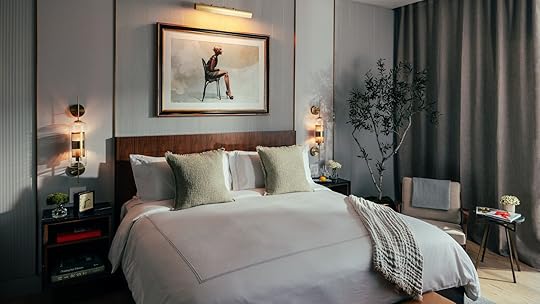
Photo courtesy The Global Ambassador
Since this was clearly a legendary local nightlife destination (I saw guests of all ages ranging from young women who were home from college for the weekend, to retirees enjoying a night out on the town), I was also worried about excessive noise filtering in from the rest of the property when I needed to rest. But I didn’t have to be.
My room was as quiet as a church during a sermon, which made it the best of both worlds – a great place to become immersed in the party vibes, and a great place to ride the elevator down two floors and go to sleep.
The design details in my room were immaculate and cohesive, making the space feel like a queen’s quarters — with creamy green and taupe hues, velvety feeling fabric textures, sturdy oak floors and tasteful artwork. One detail that struck me as a representation of how modern and “on pulse with the trends” this hotel is were the contents of the mini fridge. It’s a small detail but an important one to me as a traveler, nonetheless.

Photo courtesy The Global Ambassador
Inside the mini fridge, I found the standard cocktail mixers and some upscale curations, but there was an Olipop soda (I’ve never seen an Olipop inside a hotel minifridge before, and my younger Millennial friends and I are aII obsessed with them right now).
There were also a few Celsius energy drinks, which I appreciated, because I am a huge Celsius fan (I’d rather drink a Celsius to get amped for an evening out, or before an exercise session compared to a Red Bull — just because I like the flavors better). The mini fridge selection was unique and trendy, in addition to satisfying the desires of those who seek the traditional.
On the wall, there was an enormous TV with streaming capabilities, which meant one of my four nights on-site could be spent binging on Netflix movies. And the gorgeous marble-clad, brass-fixture bathroom and added upscale toiletry amenities was a prime place to get ready for a day or night out. I also loved how the sliding doors revealed a Juliet balcony off my room, which is admittedly too small for sitting on but large enough to step out onto and get some fresh air.
Wellness takes the crown at The Global Ambassador’s spa, fitness center, and pool
Photo courtesy The Global Ambassador
The spa at The Global Ambassador isn’t just a spa — it’s quite undramatically a life-changing encounter. I got the “Mova High Definition Lymphatic Drainage Treatment” (this property is the sole spa in the region to offer such a treatment), and it was unlike anything I’ve experienced at a spa before. I felt like I’d lost at least an inch of water weight off my waist, and as if I’d detoxed a whole month of holiday-induced food and drink toxicity throughout my body —all in a one-hour session.
The Spa features 10 treatment rooms offering a menu of facials, full-body massages, light therapy, IV drips and cryotherapy, among other offerings. The women’s locker rooms were equipped with more amenities than most high-end hotel spas. There were the standard features like a jacuzzi, a cold plunge, a steam room, and sauna facilities — but the kombucha and rose wine on tap, ice cream freezer (indulgence is sometimes necessary for complete wellness), and selection of healthy and hearty snacks made the lounge feel like a space I never wanted to leave. If they hadn’t closed at 6 p.m. I’d have been in there all night.

Photo courtesy The Global Ambassador
The formal “waiting room” for treatments featured large windows and a patio with a view of Camelback Mountain. It was just as luxurious as the locker room space, with a selection of teas, light snacks, and ample reading material to make you feel relaxed before your treatment even began.
Fitness-wise, since I like to stay active on the road, I appreciate a well-appointed fitness center, and I was enthralled with the offerings of The Global Ambassador’s gym space. The 9,000-square-foot facility featured dozens of cardio machines and weights including Technogym and Eleiko equipment — along with a Movement Studio, Spin Studio, and Pilates Room. Best of all, the entire space was designed to feature views of Camelback (which helps when you’re thinking about how it’s way too hot to hike this famous mountain at the moment — at least you can see it from afar). There are also outdoor wellness decks made for sunrise meditation sessions and outdoor classes. I appreciated the little details about the gym, such as their little healthy snack bowl and wide selection of drinks to take (not just “water,” but electrolyte beverages, as well).
Culinary selections fit for a king
Le Ame dining room. Photo courtesy The Global Ambassador
However, the piece de resistance at The Global Ambassador, the element that truly makes it stand out from other luxury hotels, is that it’s home to five original restaurants on-site influenced by Fox’s extensive international travels.
On the ground floor, Le Âme is a Parisian-style steakhouse and bistro with a wide variety of classic French dishes. The Steak Frites and Mussels en Bouillon are crowd favorites, along with tasteful dishes like Loup de Mer and Crab Tagliolini.
I dined here and enjoyed a steak paired with red wine that the hotel’s master sommelier helped me pick out to complement the flavors of my meal. Those who prefer a mixed drink over a curated glass of wine will salivate over the selection of cocktails here. Around me, while I was dining, there was a mix of patrons ranging from a group of ladies having a girls’ get together, to a couple clearly on a romantic date night, and a group of business partners discussing quarterly earnings. A bit of everyone. Plus, it felt very busy for a Wednesday evening. Le Âme is open for breakfast, lunch, dinner and weekend brunch.
I also dined at théa Mediterranean Rooftop, which is known for boasting one of the best rooftop views in the area, alongside serving delicious cocktails and Mediterranean food. When I was there, it was a weekend night, so there was a DJ playing and a buzzy atmosphere — it felt like everyone who’s anyone was on this rooftop that night, with women donning their highest heels and men dressed up in suits and sport coats.
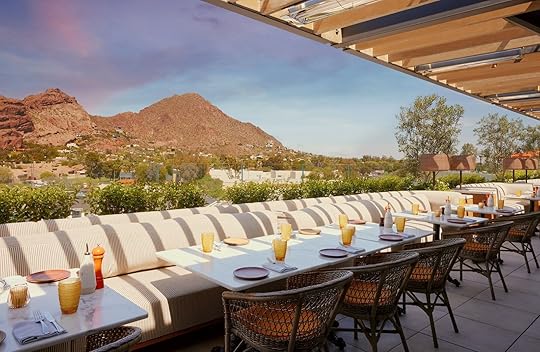
Photo courtesy The Global Ambassador
théa is also known for its pasta, coastal seafood, and skewers. I couldn’t decide what to order, so I got the “Goddess of all dips,” which came with a smattering of each of the six dips, with pita and crudités. Each dish features a mixture of flavors bound to satisfy every type of craving for a top-notch Mediterranean dish. Their cocktail program is incredible, in addition to their wine selection (they’re known for their extensive rosé collection).
And each morning, I started my day with a coffee from Le Market adjacent to the lobby and Le Âme. This space aims to pay homage to European markets, featuring a buzzy energy and tasty selection of pastries, espresso beverages, and healthy smoothies, curated cheese plates, and more. It’s a relaxing place to socialize in an upscale setting accessible to anyone walking through the area with no reservation needed.
Those who want to sit poolside and chill out can get bites from Pink Dolphin, which blends Mexican and Peruvian-inspired dishes and drinks in an alfresco setting. And finally, there’s the Lobby Bar, which offers a mixture of classic and craft cocktails and an all-day snack menu with a European flair, in a setting inside the lobby space (or outside the lush garden courtyard and patio space).
Whether you’re taking a trip to The Global Ambassador for an extended vacation, booking a spa treatment for the day, or just visiting for the evening for a date at one of their delightful dining outposts, it’s bound to be an unforgettable experience that leaves you feeling like royalty. 
February 5, 2025
The Most Beautiful Airbnbs for Scuba Diving Around the United States
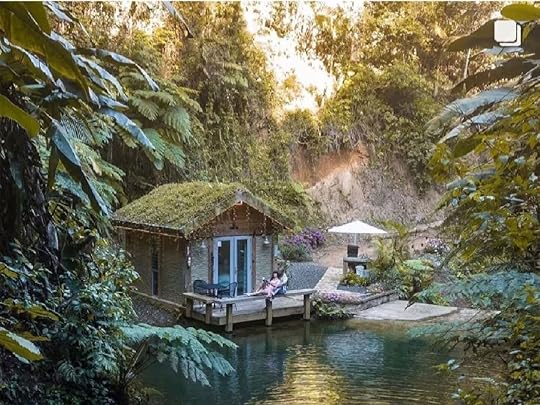
The canyons and mountains ranges of the United States may hog the glory but the underwater world is equally enthralling. In fact, with tropical islands such as the Florida Keys and Caribbean islands where a passport isn’t even needed, there’s little reason to splurge on tickets to the Maldives for diving and snorkeling adventures. Dive into these best Airbnbs for scuba diving on the islands of the United States.
Matador’s guides to the best of Airbnb Categories: 10 Remote, Off-The-Grid Airbnbs Where You Can Get Away From It All The Best Rentals From Airbnb’s New Golfing Category The 11 Most Beautiful Converted Churches You Can Stay in Around the World on Airbnb Airbnb Just Made Windmills a Category, and These 9 Have Us Planning a Trip Airbnb Now Has a Towers Category. These 9 Will Climb Your Bucket List Airbnb Launched a Tiny Homes Category, and We’re Already Planning Trips Around These 11 11 Properties in Airbnb’s New OMG! Category You Won’t Believe Are Real These Are the Coolest Properties in Airbnb’s New Play Category These Beautiful Accessible Properties Showcase the Best of Airbnb’s Adapted Category These Are the Most Impressive Listings in Airbnb’s New Trending Category These Unique Abodes Showcase the Best of Airbnb’s Top of the World Category
We hope you love these scuba diving Airbnbs! Just so you know, Matador may collect a small commission from the links on this page if you decide to book a stay. Listed prices are accurate as of the time of publication.
Oceanfront Airbnb in Key Largo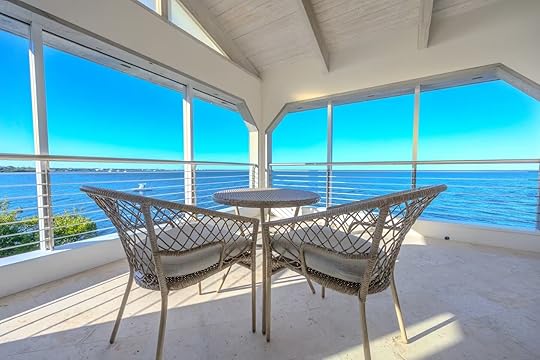 Photo: Airbnb
Photo: Airbnb Photo: Airbnb
Photo: Airbnb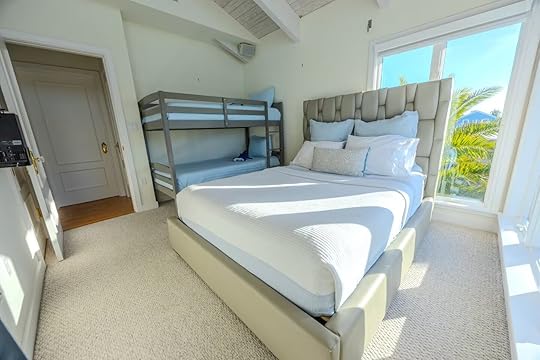 Photo: Airbnb
Photo: Airbnb Photo: Airbnb
Photo: AirbnbSee more photos
This family-friendly villa in Florida Keys has a private beach and a boat slip. John Pennekamp Coral Reef State Park is minutes away, with a host of scuba diving, snorkeling, and glass-bottom cruises to choose between. There’s plenty of space indoors as well as a large terrace overlooking the sea which is ideal for breakfast. The master bathroom has a jacuzzi tub with sea views.
Ten guests, three bedrooms
Price: $739 per night
 Photo: Airbnb
Photo: Airbnb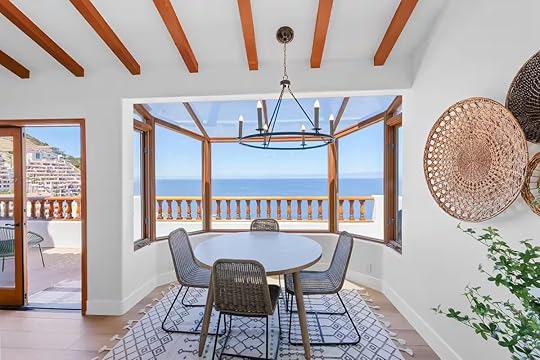 Photo: Airbnb
Photo: Airbnb Photo: Airbnb
Photo: Airbnb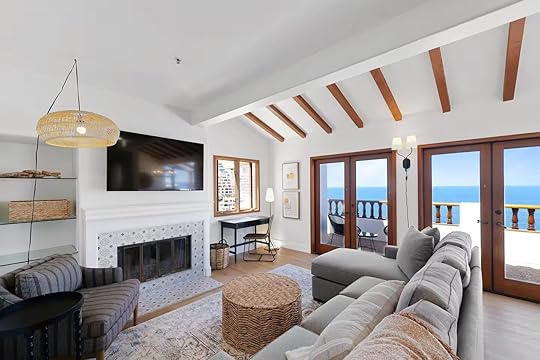 Photo: Airbnb
Photo: AirbnbSee more photos
Maroon yourself away to this Californian island with a medley of scuba diving experiences for beginners through to experts. Casino Point Dive Park, one of the few undersea parks in the world, has kelp forests and wrecks to explore amid the marine life. The apartment is lavishly furnished and has elevated Pacific views from the balcony. The host provides a complimentary golf cart for getting around Avalon.
Four guests, one bedroom
Price: $543 per night
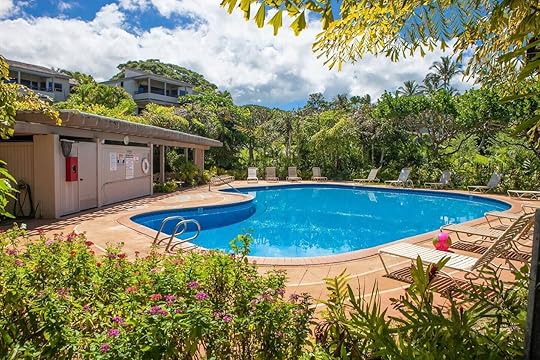 Photo: Airbnb
Photo: Airbnb Photo: Airbnb
Photo: Airbnb Photo: Airbnb
Photo: Airbnb Photo: Airbnb
Photo: AirbnbSee more photos
This Airbnb in Maui is convenient for scuba diving excursions to the Molokini Crater. It’s a modern unit with contemporary furniture, spotless bathrooms, and a beautiful panoramic lanai with nature views. This is furnished with seating for grabbing a hearty breakfast before rushing out to make the boat. The closest beaches are within walking distance and the complex has two pools.
Six guests, two bedrooms
Price: $299 per night
 Photo: Airbnb
Photo: Airbnb Photo: Airbnb
Photo: Airbnb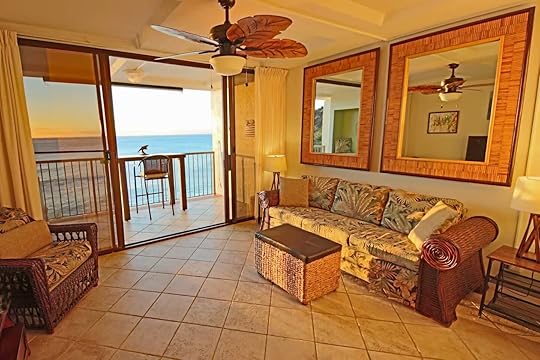 Photo: Airbnb
Photo: Airbnb Photo: Airbnb
Photo: AirbnbSee more photos
Wake up to the sound and sight of the ocean at this Guest Favorite Airbnb in Hawaii. The apartment is located far from the busy resorts on a calm stretch of coast where dolphins and whales are frequently spotted. The condo is part of a gated resort with a pool, hot tub, and sports amenities. It’s a great base for a mix of relaxation and active pursuits.
Four guests, one bedroom
Price: $328 per night
 Photo: Airbnb
Photo: Airbnb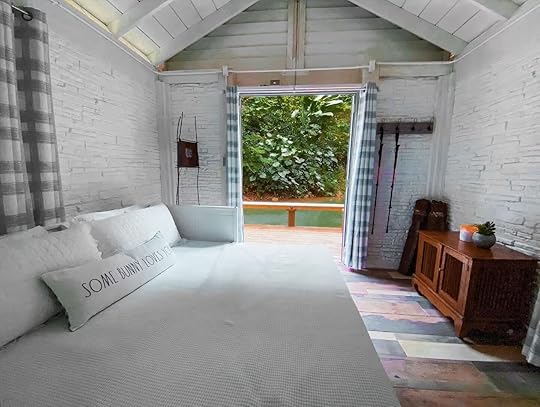 Photo: Airbnb
Photo: Airbnb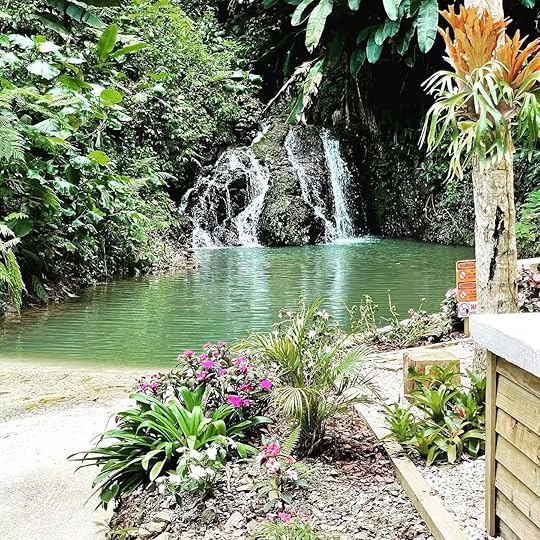 Photo: Airbnb
Photo: Airbnb Photo: Airbnb
Photo: AirbnbSee more photos
Who needs a dive shop down the road when you have a private eco-hideaway? This romantic vacation cottage is buried in the depths of the Puerto Rican rainforest with its own swimming hole, waterfall, and wood-fired hot tub. It’s close enough to the west and southern coast to take your pick of scuba trips and venture out to Mona Island. Remember to bring your mask and you can warm up in the natural pool.
Two guests, one bedroom
Price: $299 per night
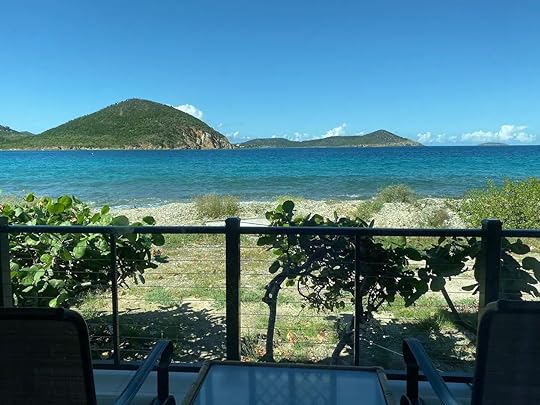 Photo: Airbnb
Photo: Airbnb Photo: Airbnb
Photo: Airbnb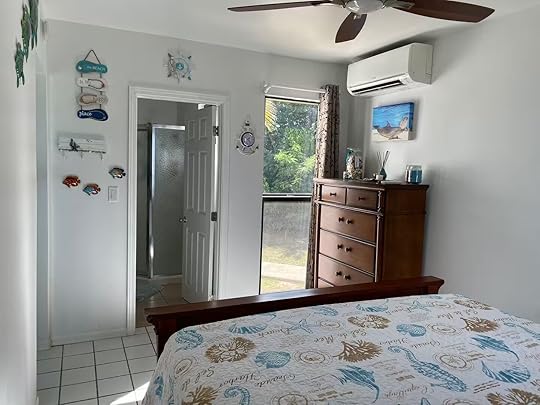 Photo: Airbnb
Photo: Airbnb Photo: Airbnb
Photo: AirbnbSee more photos
This recently renovated condo on the island of St. Thomas has a private balcony with privileged views of the boats passing to and from the marina. The decor is modern yet slightly retro for a cozier, more casual accommodation experience on the peninsula. You’ll find a cluster of dive shops in downtown Red Hook while appreciating the feeling of being on a desert island.
Four guests, one bedroom
Price: $205 per night
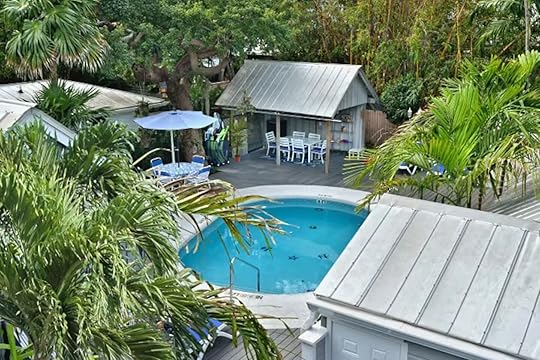 Photo: Airbnb
Photo: Airbnb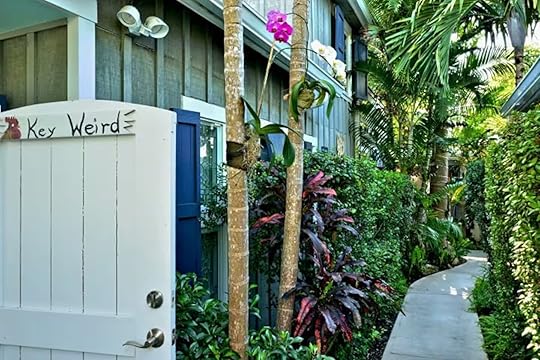 Photo: Airbnb
Photo: Airbnb Photo: Airbnb
Photo: Airbnb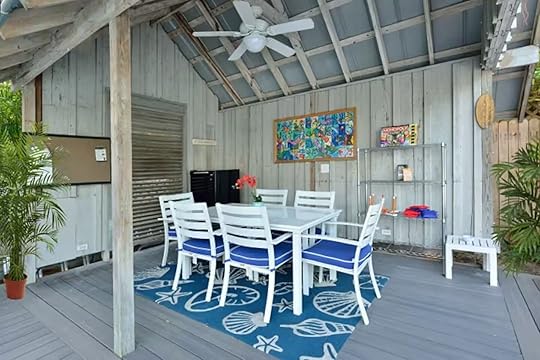 Photo: Airbnb
Photo: AirbnbSee more photos
Formerly a cigar maker’s cottage, this lovely little shack has been transformed into a retreat for couples in Florida. It has its own kitchen and bathroom plus you’ll have use of the external washroom facilities – which is handy for keeping sand away from the bed! The Airbnb has a private hot tub and grilling deck plus access to two shared community pools. There are two dive centers within walking distance.
Four guests, one bedroom (studio)
Price: $586 per night
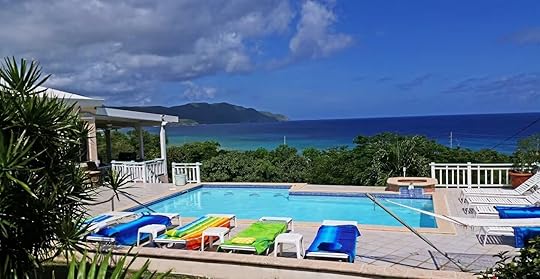 Photo: Airbnb
Photo: Airbnb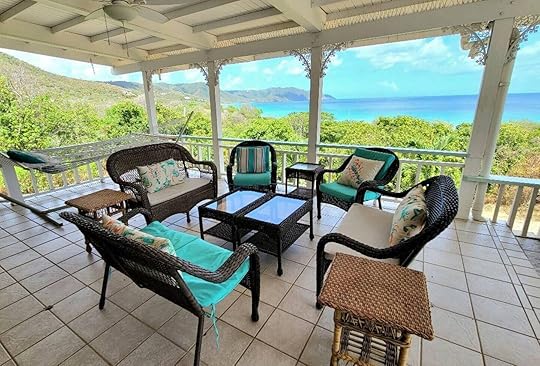 Photo: Airbnb
Photo: Airbnb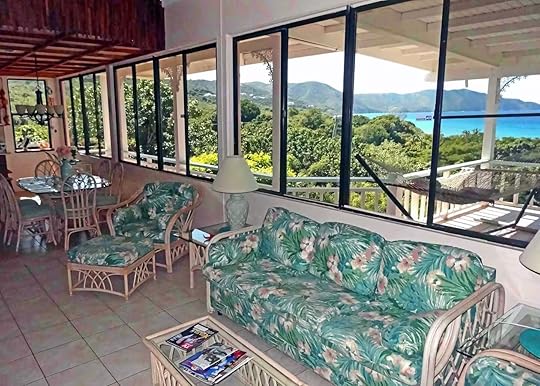 Photo: Airbnb
Photo: AirbnbSee more photos
This huge villa rental in the USVI is a top contender for scuba diving families and groups. It has a pool overlooking the Caribbean Sea and a sheltered patio for dining in all types of weather. The island-inspired decor is comfortable and all rooms come with a view or direct access to the backyard. Cane Bay Beach is the best place to scuba dive on Saint Croix.
Fourteen guests, four bedrooms
Price: $415 per night
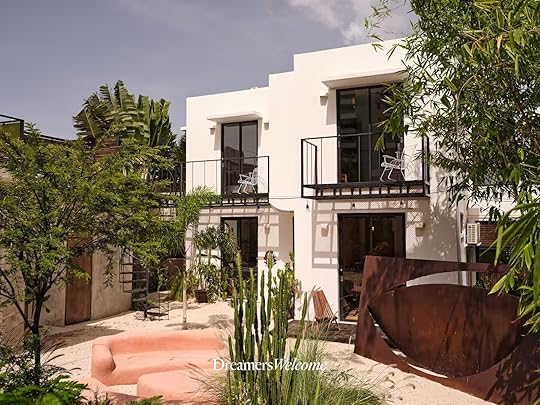 Photo: Airbnb
Photo: Airbnb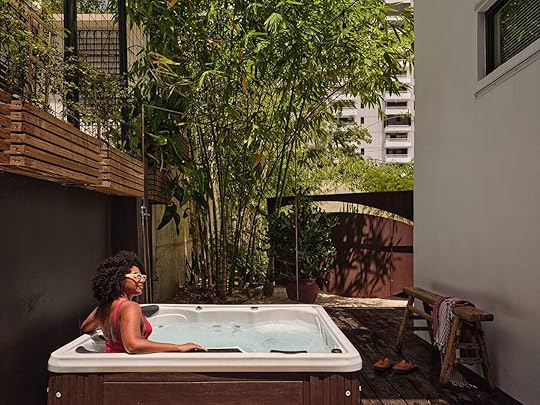 Photo: Airbnb
Photo: Airbnb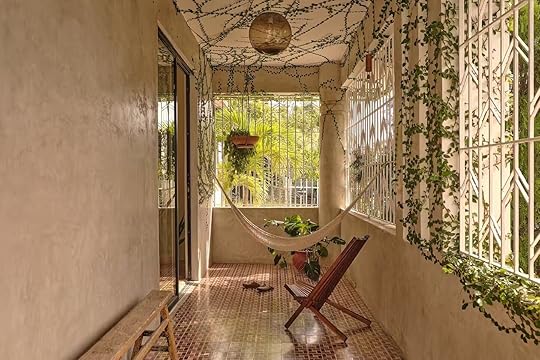 Photo: Airbnb
Photo: Airbnb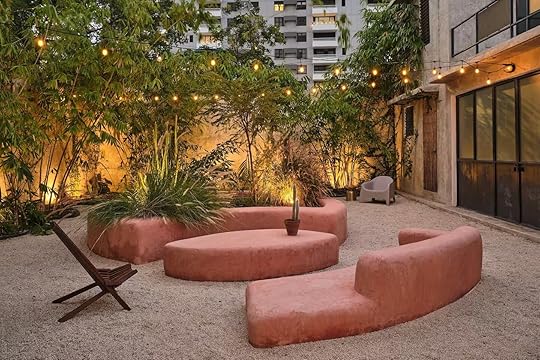 Photo: Airbnb
Photo: AirbnbSee more photos
After a day spent diving around the local islands and estuary, come and unwind in this stylish six-bedroom Airbnb with a private jacuzzi. Located in Puerto Rico’s capital, the rental is convenient for scuba tours as well as exploring the city sights. Each bedroom is individually styled and communal areas are strewn with lush vines. The overall aesthetic is sumptuously boho.
Six guests, three bedrooms
Price: $329 per night
 Photo: Airbnb
Photo: Airbnb Photo: Airbnb
Photo: Airbnb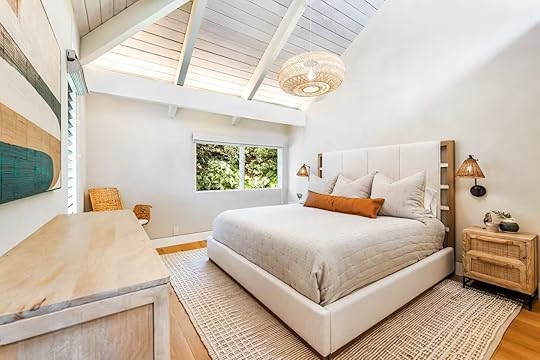 Photo: Airbnb
Photo: Airbnb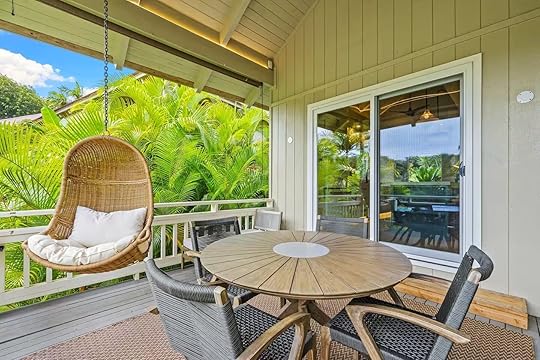 Photo: Airbnb
Photo: AirbnbSee more photos
Nestled amid the Poipu Crater, this top-rated Airbnb in Hawaii is close to dive shops and beautiful surfing beaches. The rental is appointed with hotel-standard beds, chic tiled bathrooms, and a quartz-topped kitchen overlooking the verdant backyard. There’s a shaded lanai for siestas and dining. A stroll through the fruit tree grove brings you to the shared pool or the golden sand of Brennecke Beach.

Four guests, two bedrooms
Price: $558 per night
Matador Network's Blog
- Matador Network's profile
- 6 followers



